Prelude
The odds of being struck by lightning during your lifetime are Three hundred thousand to one.
Amazingly, Lee Trevino has been struck by lightning no less than three times. He was once asked what he would do if another lightning storm came by whilst he was on the golf course?22
His answer is often quoted:
“If you are caught on a golf course during a storm and are afraid of lightning, stand in the middle of the fairway and hold up a 1-iron. Not even God can hit a 1-iron.”
He was wrong!
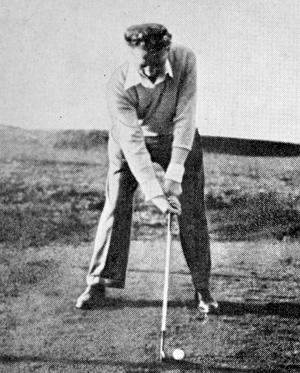
God’s One Iron
CHAPTER ONE
Roberto stood at the edge of the tee and waited. He held the golf bag upright and waited to see which club would be chosen for the next tee shot, though in his heart of hearts he knew it would be the one iron.
He was caddying for a man who was already more than a local legend but on this day his legendary status would move in a whole different direction to anything that had ever been thought of before.
Roberto and the man he was caddying for both knew that one straight drive here at the 16th would guarantee that “The Legend” would become champion, and sure enough when he strode on to the tee the big man picked up a tuft of grass, threw it into the wind, looked down the fairway and without looking at him said “Roberto, il numero uno si prega.”
There was a crowd following the match and many of the big man’s friends were there in numbers. They came from all walks of life and included Counts and Countesses, Ambassadors and politicians, and all sorts of noblemen from some of the most highly regarded families in Europe. There were diplomats and dignitaries from various countries as well as many ordinary men and women who were there solely because they believed that on this day their friend would become champion.
The jovial big man also believed that he would be champion. He didn’t often lose at golf and today was going to be no different.
To Roberto’s knowledgeable and well educated eye, however, the man he was caddying for would be more than just champion. He was an inspiration and a wonder when it came to golf and life in general.
Roberto had caddied for him on many occasions and considered himself to be one of the big man’s friends. They had talked about golf often on the way around the golf course and for young Roberto those talks had always made him more determined than ever to pursue a career as a professional golfer, and the big man encouraged every step of the way.
Now, on this day, on the sixteenth tee, as his friend addressed the ball with the one iron, Roberto wondered if the others watching saw what he saw? He wondered if they just saw a big man playing golf? He wondered if they saw or recognised any of his unique style and his bad practices as a golfer or were such technicalities completely lost on them?
Roberto saw and saw clearly.
What he saw was a man who stood six feet two inches tall and who held the club with a most unorthodox and unusual grip which was technically all wrong. What he saw was a man who was built like a boxer weighing fourteen and a quarter stones all of which went right through the ball when the big man swung the club and sent the ball sailing into the wide blue yonder. What he saw was a man with an unruly mop of wild dark hair which sat on top of his head like a big bird’s nest and which, he reckoned, was an absolute stranger to a brush or a comb.
He saw a man with a high forehead, small eyes which were usually hidden behind cheap wire spectacles, and a nose which was later described as being of “generous proportions”.
He saw a man in wide baggy trousers, a woolly jumper and an old jacket who looked nothing like what a top-class golfer should look like.
In truth, what Roberto saw was a large, striking and somewhat unusual looking man who played fantastic golf shots despite holding the club in less than text book fashion.
Roberto saw someone who could chip and putt but, most importantly, who could hit a one iron from the tee or the fairway with uncanny length and accuracy. In later years, Roberto would say that he would never meet anyone else who could hit a one iron like “il Grande Hugh”.
On the sixteenth tee, the big man straightened his left arm, settled into that unusual grip, adjusted his stance placing his right leg ever so slightly further back than his left, and slowly started on his back swing. The club came straight back and rose in an arc in almost slow motion. Roberto watched the big man’s shoulders and hips turn, his left leg bend slightly and the left heel lift as he shifted his weight onto his right foot. At the top of the back swing, the big man’s chin was tucked into his left shoulder before he started on a down swing which automatically caused the left foot to slam back down on to the ground while the hips and shoulders reversed their turn as those big hands brought the club down and forward.
At the point of contact with the ball, the big man’s left arm was girder straight, his weight shifted from right to left and as the swing continued onwards the ball flew straight and true down the left side of the fairway eventually curving inwards with a slight fade. The big man’s swing ended with club arcing upwards pointing to where he wanted the ball to go and finished with his right heel raised and the right toe almost pointing into the ground like a ballet dancer’s “point”.
Someone shouted “Great shot, Hugh!” and with that one shot the big man and everyone else knew he would be champion without doubt.
Hugh nodded and acknowledged the comment before turning to Roberto to hand back the club with a smile and a wink. They set off up the fairway together but hadn’t gone more than thirty yards before the big man said quietly “It’ll just be the 5 iron from there, me lad, so dig out the club and give the face a wee rub with the towel if you please?”
Roberto noted that not only had the big man played a great tee shot, he had already calculated exactly what was required for the second shot into the green and clearly he had played the entire hole in his head in advance.
That was how to win a golf tournament and conquer a golf course he thought.
On the Sixteenth green big Hugh sank his putt and was hailed as champion. He accepted the congratulations from all around with a smile, considerable humility, genuine thanks and his familiar warm Irish brogue.
It wasn’t every day or every year that an Irishman who was built like a light heavyweight boxer was crowned Champion at Rome Golf Club but that is what happened on this day.
Nor is it often the case that an Irishman becomes The Amateur Golf Champion of all Italy but then again Hugh was no ordinary golfer and no ordinary Irishman. He was simply a one off.
As they walked together to the locker room, Roberto asked a question:
“How do you hit your one iron like that? It is so accurate and you get great distance with it from the tee or from the fairway. Lots of players are afraid of the one iron.”
The big man stopped and looked down at his young teenage companion through his wiry spectacles:
As he spoke he swung an imaginary golf club in slow motion to demonstrate his point.
“Ah Young Roberto, you see the one iron is a matter of faith; Faith in yourself, faith in the club and most of all faith in God. The one iron is almost flat with little in the way of loft. That means if you get the swing wrong you will almost certainly mess up the shot as the one iron is the most unforgiving club in the bag. But, get the swing right then the one iron is the most steady and true club you will ever hold. It has an almost flat face, like a knife, and if you hit the ball correctly it will always deliver the same result without deviation or variation. But it all depends on your swing being consistent. Oh, and always treat the one iron with the greatest respect. Don’t call on it when you don’t need it; Don’t push it around or hit it half-heartedly; know that when you take it out the bag you will fail miserably unless you are going to work in perfect partnership with the club and once you have succeeded in finding that partnership once, you will still have to work at it each and every day as if you were married.”
Big Hugh then smiled a wicked grin and concluded “Finally, always remember that the one iron is never yours. It is a club that belongs to God. It will always be God’s one iron! But God is good, though at times he works in the most mysterious ways. With the one iron he can send you to heaven or damn you to hell!”
Years later, in 1961, Roberto would become a professional golfer and he would often cite big Hugh’s thesis on the mysteries and the science of the one iron when giving lessons.
In 1972, he would strike the ball a mere 288 times when navigating Muirfield golf course, the home of the Honourable Company of Edinburgh Golfers. It would be his best ever finish in the British open tying thirteenth only ten shots behind the eventual winner – the defending champion Lee Trevino.
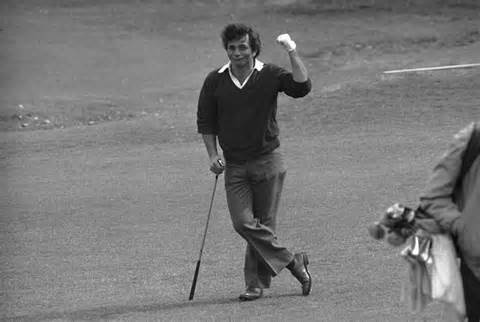
Roberto Bernardini
Previously, Roberto’s best finish had been 16th in the open and a couple of years before he had finished in the top 30 at the US Masters at Augusta. He would represent Italy on no fewer than nine occasions at the Golf World Cup. Yet no matter what he achieved in golf he would always remember and feel grateful for the “lessons” provided by his friend “Big Hugh”.
However, all of that was in the future. On this day at Rome Golf Club he was just a delighted teenager who was lucky enough to have been the caddy for the man who many thought of as the best golfer in Italy whether amateur or professional.
Less than an hour after being crowned champion however, Big Hugh sought out Roberto to say thanks and goodbye as he had things to attend to. He would see Roberto the following week when he was back at the club for his next round of golf but for now he had to go back to “the day job”.
Roberto had never met anyone like Hugh, and later in life he would admit he would never meet anyone like him again.
“Thanks for your help today Roberto, I could never have done it without you” said Hugh, though Roberto figured this was a lie.
“However, I have been away long enough today and have to go back to the day job so I will be seeing you – maybe Wednesday of next week.”
Roberto tried to persuade the big man to hang about the clubhouse a while longer but he was having none of it.
“Sure, if I don’t get back to the office I will be reported missing” said Hugh “Besides, technically it is against the rules of the job for me to be playing golf at all and don’t I have to go and say a mass and thank the man upstairs for letting me use his one iron?”
And with that, Monsignor Hugh O’Flaherty, sometime Italian Amateur Open Golf Champion, Vatican diplomat, Chief Notary to The Holy See, and the internationally acknowledged but strictly unofficial hide and seek champion of the world winked once again, turned on his heel, and left.
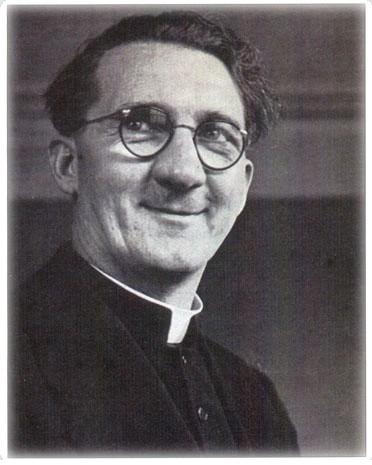
CHAPTER TWO
James O’Flaherty was a man of principle. He had been a Sergeant in The Royal Irish Constabulary but after months of wrestling with his conscience James had finally handed in his notice and left the police force.
Whilst he believed in law and order he eventually took the decision that he could no longer enforce laws and actions in which he simply did not believe and which he objected to fiercely more often than not. Ireland was a place of great conflict with many pressing for Home Rule which was hugely resisted by the British Government. One means the Government used to suppress any notion of home rule was by way of brute force dished out by armed soldiers and militia, and the worst of this force was provided by the dreaded “Black and Tans”.
As a policeman, James was forced to not only co-operate and work with government policy but was also asked to enforce certain procedures and actions as well. He was also asked to turn a blind eye when the forces of the crown overstepped the mark and handed out brutal beatings and worse to the Home Rulers or the ordinary people of Ireland.
James had considerable sympathy with the home rule argument and eventually he could stand it no more and so he left the police force in Kiskeam, County Cork for good.
Fortunately, he quickly managed to find another job as the caretaker and Steward at The Old Killarney Golf Club in Deerpark, Killarney County Kerry. The O’Flaherty’s were given a house situated on the edge of the course and James, his wife and children settled down to life a million miles away from policing.
However, there was still conflict, The Black and Tans were active in the area and many people James knew suffered at their hands.
Another conflict in James’ life surrounded the activities of his oldest son, Hugh.
Golf was a game for the gentry and the upper classes, but as he looked out his window of an evening, there was Hugh hitting golf balls in the dusk as if he belonged on a golf course.
By his mid-teens Hugh was a scratch golfer. He was good at all sports. Big enough and fit enough for boxing, he could use a hurley and was generally athletic, but it was clear that his main talent lay on the golf course.
However, boys of his background didn’t belong on the golf course although James had to admit that Hugh seemed to get on well with members and those who would consider him as their social inferior. He had a charm about him that boy!
When Hugh announced belatedly that he wanted to be a priest there was great joy in the family. To be a man of God was thought of as a great honour, and for James it provided a degree of relief as Hugh would be heading for the seminary and away from the violence and oppression of the Black and Tans.
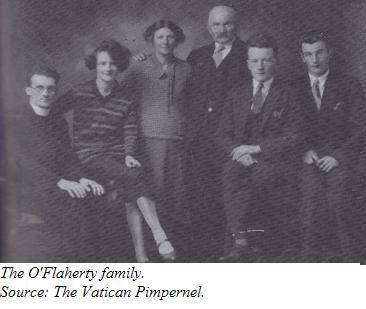
However, priest or no priest, Hugh O’Flaherty would grow up to be fiercely republican and with little or no respect for British rule. When four of his friends were killed by the Black and Tans in separate incidents he was outraged and was not slow to tell others how he felt.
Things were getting ever more heated in Ireland and James was more than delighted when Hugh announced that he was leaving for Rome in 1922. Having attended a Jesuitical seminary in Ireland, for one reason or another it had been decided that “Big Hugh” should complete his studies in the Eternal City and James thought it was for the best that his boy got out of Ireland even though by that time “the boy” was a fully grown 24-year-old man of not inconsiderable build.
In Rome, Hugh entered the Urban College of the Congregation for the Propagation of the Faith, and amazed his former teachers in Ireland by earning his theology degree in just one year. He was then ordained in 1925, and spent another two years at Urban College, serving as vice-regent and earning three doctorates in Divinity, Philosophy, and Canon Law.
Rather than return to Ireland, Hugh was chosen to stay in Rome and set to work in the offices of The Holy See in the Vatican. Someone, somewhere thought he had a future!
In 1934 he was appointed as a Monsignor (as was the custom for clergy of a certain position within the Vatican) and it was in this year that he started out on a series of diplomatic missions on behalf of the church. His future within The Vatican had seemingly moved to another level.
At first he was appointed as deputy and secretary to Monsignor Torquato Dini, but when Dini suddenly died Hugh had to perform the required duties on his own.
Both he and the Church quickly discovered that with his natural charm, and his rich Irish brogue and wit, he was ideally suited to diplomacy.
For the next four years, he would be sent on a variety of difficult diplomatic missions to places such as Egypt, San Domingo and Haiti (where he was decorated by the presidents of both islands for his work on famine relief), and finally to Czechoslovakia where the nature of his assignment has never been made clear, although it’s likely it had something to do with the hostility that was beginning to be obvious all throughout Europe. In countries such as Czechoslovakia the church and the clergy was under threat and whatever Hugh’s mission was it was to do with that threat and how to deal with it.
In 1938, with a real prospect of war on the horizon, he was recalled to the Vatican to start a new job as Notary or Writer to the Holy Office and he would eventually rise to the position of chief Notary being the first Irishman ever to hold that position. This job involved him being engaged in the inner workings of the Vatican, dealing with issues of Canon Law, checking claims of miracles and recording various matters in document form and being responsible for sending out official proclamations and statements. It meant that he had access to the people who ran Vatican City and the senior members of The Curia who ran the Catholic church.
However, being back in Rome also meant he had time to spend in and around the city and so he started to make himself known among the great and the good of Roman society, going to numerous parties where he was a great hit because of his relaxed manner, his charm, his Kerry brogue and his roguish sense of humour. The big Irishman could be found at the very best parties, at the opera and at nearly every social and sporting occasion the Eternal City had to offer.
The return to Rome also meant that he could resume his love of golf and he would often be found playing at the Rome golf club with government officials and diplomats, including Mussolini’s son-in-law, and with the former king Alfonso of Spain. On one occasion, the retiring Japanese Ambassador had his final round in Rome ruined by Hugh whose play completely dwarfed the abilities of the diplomat who was soundly beaten by the priest.
The Big Man was to become incredibly popular in Rome’s fashionable set and was a welcome dinner guest at the Palazzo’s and diplomatic offices around the city. He also boxed, played handball and could occasionally be seen with a Hurley stick from time to time when walking around the Vatican gardens.
However, golf was his main sport even though there was technically a rule which prohibited priests from playing the game. Notwithstanding the rule, he would sneak away from the Vatican whenever possible to play golf and despite the rules of Mother Church he entered and won The Italian Amateur Open Championship in between fulfilling his duties in the “day job”.
Yet, his activities did not meet with universal approval within the Vatican and some saw him as far too worldly to be a Vatican official. For a start, he was not Italian, did not come from a family who had any previous history of serving the Holy See and he was regarded with some envy because of his familiarity and friendships with officials and diplomats from all over the world. Also, he had a rude disregard for ceremony and red tape and to some this meant that Big Hugh would never fit into the regimented world of The Curia where once you had reached a certain position you were expected to behave in a certain manner and follow a certain line. For some, Hugh O’Flaherty, simply didn’t fit the traditional “Vatican” mould.
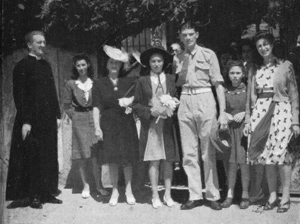
Hugh O’Flaherty in Rome with the family of Henrietta Chevalier
On 2nd March 1939, Cardinal Eugenio Pacelli was elected Pope taking the name Pope Pius XII. Pacelli was the first native born Roman to become Pope for over two hundred years and he came from a family which had historically close ties to the workings of the Vatican.
Pacelli, was seen as a member of the “Black Nobility” (historically noble families who served the Vatican) from the outset. His grandfather, Marc Antonio Pacelli, had been Under-Secretary in the Papal Ministry of Finances, then Secretary of the Interior under Pope Pius IX from 1851 to 1870 and had helped found the Vatican’s newspaper, L’Osservatore Romano, in 1861.
His cousin, Ernesto Pacelli, was a key financial advisor to Pope Leo XIII; his father, Filippo Pacelli, a Franciscan tertiary, was the dean of the Roman Rota; and his brother, Francesco Pacelli, became a lay canon lawyer and the legal advisor to Pope Pius XI, in which role he negotiated the Lateran Treaty with Mussolini in 1929.
In short, Eugenio Pacelli was born to be “papable” as the saying goes. He had all the connections, a holy vocation, was a man of God and knew how to climb the ranks of the Curia.
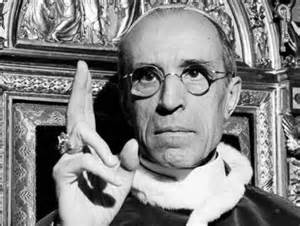
Eugenio Maria Giuseppe Giovanni Pacelli – Pope Pius XII
By the time he became Cardinal Secretary of State and Camerlengo of the Holy Roman Church (effectively the Foreign Secretary and Chancellor of the Exchequer to the Vatican) Cardinal Pacelli had served as Papal Nuncio in Germany and was seen as a clever diplomat within Vatican circles. By 1938 he had already made outspoken speeches concerning Adolf Hitler and the Nazi party in Germany and so when Pope Pius XI died in February 1939, Pacelli was elected his successor (as openly wished for by Pius XI) in one of the shortest conclaves in history. He was an automatic shoe in for Pope and, perhaps, rightly so.
Upon his election, the new Pope appointed Cardinal Maglione as Cardinal Secretary of State but Maglione would never exercise the kind of influence held by his predecessor, Pacelli, in that role. Instead, Pope Pius XII chose to consult and rely more and more on the two men who had acted as his personal assistants when he was Cardinal Secretary, namely Monsignors Giovanni Montini and Domenico Tardini both of whom knew and respected the Vatican rule book and its inner workings.
Monsignor Montini, in particular, was very close to the new Pope and would later observe how Pope Pius completely gave himself over to the spiritual and physical demands of being Pope while abandoning all other personal interests and pastimes.
It would be fair to say that Montini was among those who raised an eyebrow or two at the social and sporting activities of his Irish counterpart in the office of The Holy See. Where the new Pope gave himself over to spiritual matters completely, the Irish Monsignor seemed to give himself over to parties and sneaking off to the golf course in between his office commitments. In Montini’s eyes, the two men, despite both being ordained priests, were very different indeed.
In September 1939, only six months after the election of Pius XII, Germany went to war and on 10th June 1940 Italy, somewhat reluctantly, did likewise despite pleas from Winston Churchill, the new Pope and various other leaders.
Mussolini and Hitler had signed a “pact of steel” and while Mussolini was keen in expanding the boundaries of Italy he and his Government did not anticipate any military movement until 1942 at the earliest and so when Hitler unilaterally entered Poland and Czechoslovakia the Italian leader was wholly unprepared for the fall out.
Mussolini had come to power in Italy in the same year that big Hugh arrived in Rome (1922). In 1929 Il Duce had signed the Lateran treaty with the Pope creating the sovereign and independent state of Vatican City. However, part of that treaty specified that the Pope would not interfere in the affairs of Italy AND it stated that in the event of any conflict in Europe the Vatican would remain strictly neutral failing which its sovereignty would be compromised.
This then meant that the Irish Monsignor who loved to golf and attend parties in Rome was destined to be a “neutral” throughout the course of the war on two separate grounds. First he was an Irish citizen (Ireland remained neutral) and secondly he was a Vatican diplomat and a resident in Vatican City and so his Vatican papers also confirmed his neutrality.
However, the same treaty and the terms agreed also meant that the new Pope and his closest advisers were constantly afraid that if they incurred the wrath of Hitler or Mussolini the Vatican State would be invaded, its sovereignty removed, and the Pope himself would be kidnapped and held prisoner.
Where the Pontiff was always wary of an enforced neutrality and almost always remained a “prisoner” within the Vatican, the big Irishman would revel in his neutrality and the diplomatic immunity bestowed by the church and his country of birth which allowed him to come and go wherever and whenever he pleased.
Thus, it came to pass that sociable Hugh would enter the war years enjoying the diplomatic freedom of an Irish citizen of the Vatican. It was a legal position he was about to use, and indeed abuse, to astonishing effect.
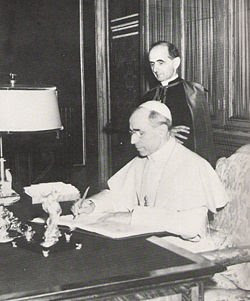
Pope Pius XII with Monsignor Giovanni Montini in the background
CHAPTER THREE
With the outset of war, the big Irishman’s job within the Vatican changed completely. Pius XII would come in for both praise and criticism for the Vatican’s stance during the war and in unbelievably trying times his inner office and men like Maglione, Montini and Tardini were under constant administrative and spiritual pressure.
For his part, Big Hugh was given an additional role to that of Notary in the offices of the Holy See. By 1941, thousands of prisoners of war and various other groups who had been displaced by the hostilities were being held in prison camps throughout Italy especially in the north of the country. Pius XII wanted to appoint a special Papal Nuncio who would visit these camps to ensure that prisoners of war, Jews and others who had been “displaced” were being properly and humanely looked after and that they had access to spiritual guidance if required. For the job the Pope turned to Monsignor Borgoncini Duca.
However, Duca spoke no English and it was decided that he should be allocated an English-speaking assistant and interpreter to deal with British POW’s and so it came to pass that someone suggested Hugh O’Flaherty. Perhaps Hugh was suggested because it was anticipated that the new job would get him out of Rome, keep him off the golf course and away from parties and the opera with the “social set”?
If that was the intention it was about to fail spectacularly!
Working with Duca it soon became clear that he and the Irishman had very different ideas about how they should go about the job of visiting the POW camps. Duca took a slow paced an unhurried view in performing the job. Travelling by car he would visit one camp per day at best and would perform not much more than a cursory visit before moving on to have lunch or dinner at a local hotel.
Hugh on the other hand, while accompanying the Papal Nuncio, would spend much more time with the imprisoned men, noting their details and making enquiries of the camp commandants as to the provision of Red Cross Parcels and the availability of Mass and other social and spiritual activities.
While Duca stayed out in the country, Hugh O’Flaherty started returning to Rome every night by train and singlehandedly set about initiating several procedures which would become Vatican practice throughout the remainder of the war.
First, he delivered the names and details of all of those he had met in the POW camps to Father Owen Sneddon who would then broadcast those details in English on Vatican Radio. In this way, news of thousands of POW’s who were deemed missing in action was relayed back to their families letting them know that they were alive and serving as prisoners of war.
Next, he contacted the Red Cross and set about speeding up and better organising the delivery of Red Cross Parcels. When entering the Prison Camps, the Irishman would demand proof that the Red Cross parcels had in fact been delivered to the appropriate prisoners and if that proof was not forthcoming he would make official complaints. This eventually led to two POW commandants at Modena and Piacenza being sacked and replaced.
From inside the Vatican he began to organise the delivery of blankets, clothing, books and other items to the POW camps. While Duca would stick to doing things by way of official channels and through camp Commanders, Big Hugh would, as often as not, completely ignore the red tape and had the blankets books and clothing delivered directly to the men on entering the camps.
There was no doubt that his visits to the camps raised morale among the prisoners and of course wherever and whenever he could he would deliver what news he had about the current state of the war. When visiting South African and Australian prisoners at a camp near Brindisi, O’Flaherty suddenly started to distribute musical instruments such as guitars and mandolins to help with moral and all round wellbeing. This was not best appreciated by the prison guards and their masters.

Hugh O’Flaherty was still no lover of the British Army and remained fiercely republican when it came to Ireland or indeed anywhere else under British rule. At the start of the war he did not see the imperialist ambitions of Britain and Germany as being very different and viewed the propaganda of both Governments with suspicion.
However, through his work in the prison camps he became alarmed at the way prisoners of war were being looked after and, of course, he heard story after story about the treatment of The Jews at the hands of German officials.
There were many areas which were technically under Italian rule even though there were German officials in charge. Prisoners often travelled many miles to be kept in Italian custody rather than in German custody as Italian custody was seen to be a fairer regime, and when they did travel news travelled with them.
Towards the end of 1942, The Italian/German authorities had come to see the Irish Monsignor as more of a nuisance than anything else and not for the last time they decided to try to confine him to within the Vatican.
The decision was made at the very highest level to make a formal complaint to the Pope about the conduct, behaviour and the so-called “diplomatic” activities of Monsignor Hugh O’Flaherty.
Consequently, Pope Pius and his advisors, ever careful to maintain and ensure the Vatican’s sovereignty and demonstrate their outward position of neutrality, recalled Big Hugh to Rome and assigned a replacement to Monsignor Duca.
Once again, O’Flaherty returned permanently to Rome and was therefore free to spend his days in his office and his evenings walking freely through the Eternal City and going to dinner with the great and the good of the city. He even managed the odd game of Golf on the quiet.
However, his travels around the prison camps had changed his view of the war and at least in one respect he was no longer a neutral.
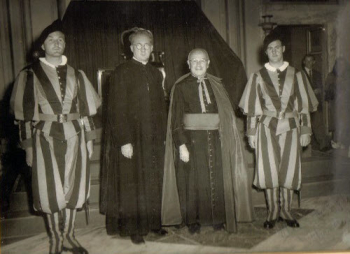
CHAPTER FOUR
Despite the Vatican’s official position of neutrality, by 1943 Adolph Hitler had become increasingly frustrated at the public pronouncements of Pope Pius XII and the critical broadcasts which were coming from Vatican Radio.
In 1940 the Pope had granted an audience to Nazi Foreign Minister von Ribbentrop who asked the Pope during the meeting why he had decided to side with the Allies in the war? Pius apparently reminded the minister that the Vatican was neutral in any conflict but then went on to quiz him directly about atrocities carried out against Christians and Jews in Germany, Poland and Czechoslovakia. The news of the altercation was carefully leaked and Pius’ defence of both Jew and Christian made the front pages including that of the New York Times.
When German forces invaded Holland, Belgium and Luxembourg the Pope had sent messages to the governments of those countries expressing regret and sympathy but carefully fell short of condemning the aggressors.
The Italian Government under Mussolini had never shared Hitler’s desire to persecute and extinguish the Jews and in Italy it was widely accepted that if a Jewish Family or an escaped Prisoner of War sought shelter they would be fed and watered without fear of harm or betrayal. Many Jews throughout other parts of Europe believed they were better off in Italian hands than in German custody as Il Duce had seemed reluctant to send Jews to concentration camps and instead merely held them as prisoners of war.
In his Christmas address in December 1942, Pope Pius openly criticised the atrocities committed by Germany with the result that the official view of the Third Reich was that the Pope had made “one long attack on us and everything we stand for!”.
The speculation that Hitler would put pressure on Mussolini, order the invasion of the Vatican and the removal of the Pope heightened.
However, 1943 would see a dramatic twist in the tide of war and for Hugh O’Flaherty the year would bring in an almost unimaginable sea change to the extent that his life would never be quite the same again.
During his travels to the prison camps, Big Hugh had told any prisoner who would listen that in the event of their ever escaping or finding themselves free, they should make their way to the Vatican where they would undoubtedly find help and sustenance.
Many would remember the big Monsignor and his advice.
CHAPTER FIVE
By late 1942 and into 1943 the atmosphere within the city of Rome and across Italy generally was becoming more tense. Many Italians felt that they had been bounced into war and the popularity of Mussolini was on the wane.
Not only that but there now started to be a more dictatorial attitude towards “undesirables” who were opposed to the war and who might be deemed as enemies of the state.
In Rome, where high-ranking German officers were stationed to provide “advice” to their Italian counterparts, it became increasingly apparent that opponents of the war were being rounded up and detained.
Many of these undesirables were personal acquaintances of Hugh O’Flaherty and his party set and slowly but surely in the later part of 1942 they came to look to the big Irishman for advice and guidance in the face of potential arrest.
It was in these circumstances that Big Hugh began to take an active part in helping various people to escape the clutches of the fascist authorities. He started by offering to find them somewhere to stay out of the reach of the fascist police and their German advisers but soon enough his initial activities were to be dwarfed by the most unusual and completely unofficial stance he decided to adopt.
By mid 1943 it was clear that most Italians had had enough of Mussolini and his pact with Hitler and in a clever political sleight of hand King Vittorio Emmanuelle summoned Mussolini to his palace on 25th July 1943. Once there, The King sacked the Italian leader and effectively placed him under arrest.
This was a move which completely wrong-footed Adolph Hitler and he was said to be furious. He immediately suspected that the Italians would find a way to do a deal with the Allies and so he demanded swift action and concocted a plan to restore order in Italy.
He would have his troops find Mussolini and free him, but more importantly he would occupy Rome and place it under official German rule with his officers running the city.
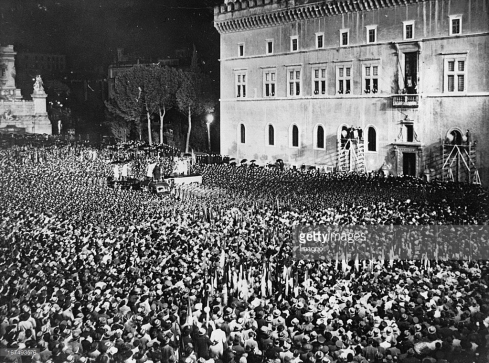
Mussolini addressing the crowds in the Piazza Venezia Rome
Even before Mussolini was removed, Pius XII was terrified that his native city would become a war zone. The Allies had landed on Sicily on 9th and 10th July and The Pope could see that mainland Italy would soon be the scene of horrific fighting. Through diplomatic channels, including the British Ambassador to the Holy See, he was in touch with Winston Churchill and President Roosevelt and had begged that there should be no damage to Rome and especially the Vatican and holy sites around the city.
Despite his pleas and the best assurances of the President and The Prime Minister, on 19th July Pope Pius’ worst fears were realised when the Allies commenced air raids on Rome.
For hours allied planes flew overhead and while they were careful not to release bombs over Vatican City itself, they did cause substantial damage to the San Lorenzo district of the city near where Pius had been brought up.
When the bombing stopped, Pius did something that he had never officially done before. He summoned a car and Monsignor Montini, left the sanctuary of the Vatican (he had been in constant fear of kidnap by the Germans and so had remained within his own sovereign territory) and set out into his native city to inspect the damage to his city and his people. If he were going to be detained and kidnapped, then this might be the time.
While Pius went out and walked among the rubble and the people, Monsignor Montini handed out money to those who had had their homes destroyed and who were now destitute.
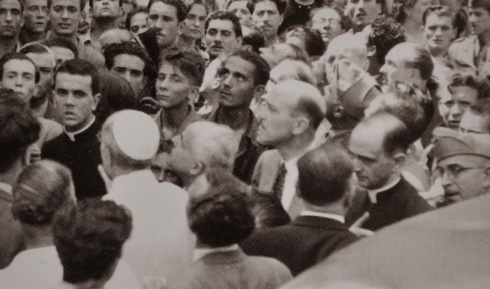
Pope Pius XII on the streets of Rome after Allied bombing on 19th July 1943 – Monsignor Montini behind him.
Pius was greatly shaken by the events of 19th July 1943 and after the arrest of Mussolini a few days later and the subsequent occupation of Rome by German forces in September 1943, the Pontiff was in no doubt that the war and all its horror was on his doorstep.
The Vatican was still neutral and was in theory guaranteed its freedom and sovereignty but from then on The Holy See was treated with increasing suspicion and remained under constant threat from the new rulers of Rome. The Pope would come under immense pressure, live in ever-increasing fear of Vatican City being invaded by force and would have to face the heightened wrath and anger of Adolph Hitler and his soldiers in Rome …….. and one of the main causes of that anger and those threats was to be the tousled haired Irish Monsignor who had a habit of waltzing around the great houses and embassies of Rome with diplomatic immunity, going to parties, and playing golf.
CHAPTER SIX
When war started, various diplomats were moved into the Vatican where they could be guaranteed safety as they were effectively resident in a neutral country. One of these was the British Ambassador to the Holy See and he went by the name of Sir D’Arcy Osborne.
Osborne was a career diplomat and epitomised the type of chap who would be appointed as a British Ambassador and so, on the face of it, he would be the kind of man who a Republican minded priest would have no time for.
When Osborne came to live in Vatican City he was offered simple accommodation in the Casa Santa Marta situated within the Vatican Walls. The Santa Marta was a sort of basic hostel which was used as a kind of hospital and later provided “basic” accommodation for visiting clergy. Not finding the initial layout of the simple Casa to his liking, Osborne quickly set about refurbishing parts of the building to resemble a residence that was a bit more like the accommodation befitting of an Ambassador.
From these offices, he shuttled diplomatically between the Papacy and The Foreign Office in London (by telephone).

Sir Francis D’Arcy Godolphin Osborne – Later 12th Duke of Leeds- British Ambassador to the Hole See – Otherwise known as “Mount”!
However, despite their apparent cultural and historical differences, by 1943 the Irish priest and the British diplomat had formed a most unlikely alliance and friendship. They were at the very heart of one of the most astonishing and dangerous escapades undertaken by anyone during the war years and from mid-1943 onwards they tread an ever more dangerous line.
Monsignor O’Flaherty had started hiding Roman citizens from the Fascist authorities in 1942 but with the arrest of Mussolini thousands of POW’s were suddenly left unguarded in camps around Italy. Many remembered the words of advice spoken by the big Irish Monsignor who had told them that if they ever needed shelter they should make their way to the Vatican.
One of those was a British sailor by the name of Albert Penny who walked out of the Prisoner of War Camp where he was being held, grabbed some overalls and a bicycle, and eventually cycled straight into Vatican City looking for help.
By pure chance Penny was taken to Sir D’Arcy Osborne’s office and was eventually given shelter. However, he was soon followed by others who for one reason or another asked for Monsignor O’Flaherty. So, started what became known as the Rome escape line.
Osborne could not play any official part in the hiding of escaped prisoners of war for fear of causing a huge diplomatic problem and compromising both the British Government and the Holy See. Nor could the Pope or his officials be seen to be housing any escaped prisoners of war and so they too had to be “officially” kept in the dark.
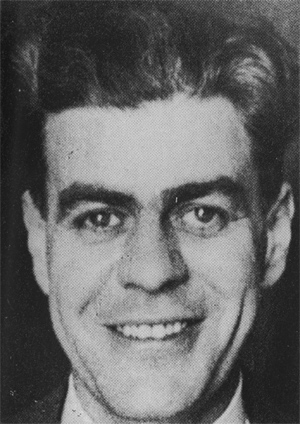
John May – The Resourceful Butler
Neither Osborne nor the Pope were unsympathetic to the plight of the escapees but both feared the repercussions of the German authorities catching them breaching their neutral or diplomatic positions.
Accordingly, when the Vatican began to be inundated with escaped prisoners and others under threat, it was left to Hugh O’Flaherty to take a stance and decide whether to offer them some shelter …… somewhere!
As the days passed, and the number of people seeking refuge through the Vatican increased, the big man from Kerry started to hide people all over Vatican City and beyond. He would take them in, have them fed, provide them with clothes and provide them with accommodation in every nook and cranny of the small state. In due course, he would call on all and sundry, including everyone he could trust in “The Party Set” to help him hide escaped prisoners of war. At first it was only a few prisoners. Then it grew to a couple of dozen and then it became a flood.
Osborne couldn’t do anything officially but he started to fund O’Flaherty’s activities privately as did other diplomats and members of Rome’s smart set who were sympathetic to the allies and who were persuaded by the Monsignor to help feed and clothe the escapees. Now when O’Flaherty went to parties he spent his time arranging safe houses and collecting money which helped to house and feed escaped prisoners.
Osborne, to O’Flaherty’s initial astonishment, provided the services of his private butler, a cockney called John May, who scrounged and foraged on behalf of the Monsignor to find clothes, food and other items throughout Rome. O’Flaherty would describe May as a genius of a man and that genius was needed as the tide of escapees coming to St Peter’s became ever greater.
Soon the Vatican, including O’Flaherty’s own quarters (ironically in a building known as “The German School” or The Collegium Teitonicum) were bulging with escaped prisoners and other refugees, so much so that O’Flaherty began to rent flats and find other accommodation for the fugitives throughout the city. Getting the men across the city under the noses of German and Italian Fascist troops was dangerous and so Big Hugh began to disguise them as priests, Swiss Guards, Policemen and various other personnel.
The Monsignor was soon hiding hundreds of men who were on the run and who were now being hunted actively by an increasingly annoyed German command. It would later be said that the position in Rome had developed into the world’s biggest game of hide and seek. It was to prove a hugely dangerous game for Hugh O’Flaherty but one at which he would prove to be masterly.
CHAPTER SEVEN
When Hitler decided to free Benito Mussolini from captivity one of the men he relied upon heavily was Herbert Kappler.
Kappler was a career soldier and a dedicated member of the Nazi Party. He was also the chief SS officer in Rome and in charge of the activities of the Gestapo. It was through Kappler’s activities that the Germans were able to locate Il Duce and rescue him from his captors in September 1943.
Once released, Mussolini would head a puppet Government in the north of Italy but he would never really return to power.
However, Kappler was given the task of ruling Rome with an iron fist with strict instructions to ensure that there was order and obedience to the demands of the Third Reich.
Whereas before there had been little activity against Jews, Kappler was now ordered to start rounding up the Roman Jews for transportation and the final solution. He was also asked to ensure that the resistance to the Germans in Rome was quashed and, not unsurprisingly, he was also asked to recapture the thousands of POW’s who had escaped from the camps after Mussolini’s downfall.
Once it became clear that Kappler was enforcing his master’s instructions, even more people started to seek out Hugh O’Flaherty and to seek help through The Vatican. Big Hugh had many Jewish friends in the city and sure enough many of them now came to the big Irishman in fear of their lives.
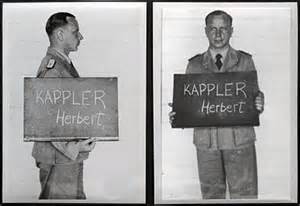
The Vatican had previously ordered that Jews seeking shelter should be housed in Catholic churches throughout Italy and of course in Rome certain churches were deemed to be the property of the Vatican state. By the end of the War some 3,000 Jewish citizens were officially under the care of the Vatican with many being housed in the Pope’s summer residence at Castel Gandolfo.
However, quite separately, Hugh O’Flaherty started to hide Jews in churches and elsewhere through his network of contacts. He was not alone in this as others such as Monsignor Montini also privately advocated giving shelter to those who were hiding from the Germans. However, no one in Rome became so involved and took as many risks as Hugh O’Flaherty did. Indeed, many within the Curia, including Montini, took the view that O’Flaherty was taking far too many risks and was placing the Pope and the Vatican in great danger. However, officially the Pope and his advisers knew nothing about O’Flaherty’s operations and so they could not readily be seen to interfere.
Kappler would send over 2,000 Jews to the concentration camps and of these only 16 or so were ever seen again. Many others simply disappeared from the streets of Rome, went into hiding and so could not be found by the Germans when they came calling.
Kappler expected this and could understand it. He would seek out the Jews who he knew were hiding and being hidden somewhere. However, what he and his superiors could not fathom out was just where all the prisoners of war had gone? They were nowhere to be found and it became clear that someone somewhere was also hiding them. Not being a stupid man or lacking in guile and intelligence, Kappler soon became convinced that the man behind the hiding of all of these people was the large bespectacled Irish Monsignor with the mad hair and the big nose.
As Berlin became ever more vociferous in demanding to know where the escapees, many Jews and known opponents of the Third Reich were, so Kappler came under more and more personal pressure. His boss, Herr Himmler, let the Pope know that the Vatican was suspected of hiding fugitives and, in particular, it was explained that the activities of Monsignor O’Flaherty were neither appreciated or unknown in Berlin. The Pope was asked politely to stop the Monsignor’s activities but Pius claimed to know nothing and declared that The Holy See would remain neutral and true to The Lateran Treaty.
In truth Pius, could hardly escape knowing (unofficially) what was going on as Vatican City was crawling with all sorts of people who were hiding there in one capacity or another.
However, as O’Flaherty and his crew of conspirators hid more and more people so did Kappler’s fury grow until The Gestapo chief finally made it clear that should the wandering Monsignor be caught outside the confines of Vatican City he would be shot. Once again, German officials tried to confine the man from Killarney within the Vatican.
This then led to one of the most astonishing games of cat and mouse that the war would ever see.
By this time, O’Flaherty was being aided and abetted by numerous people including an escaped British Major called Sam Derry, Count Sarsfield Salazar from the Swiss legation who was resident in Rome and numerous others including May and Sir D’Arcy Osborne.
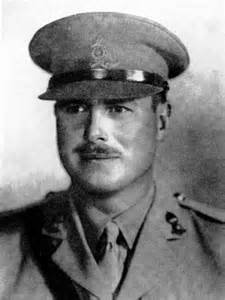
Major Sam Derry
O’Flaherty, May, Salazar and Derry would be deemed the “Council of Four” but beyond them there were many others throughout the city who were all heavily involved in “The Rome Escape Line”.
They had a sophisticated series of codes and a well organised line providing food, clothes, money and even false papers and identity cards for all of the hiding escapees and Jews.
Kappler knew there was an organised escape line and he would search numerous houses around Rome in an attempt to find the hiding places of the escaped prisoners and others whom he wanted to arrest. He often just missed his targets, with his intended victims escaping by the skin of their teeth having been warned that the Gestapo were on their way only minutes before they arrived.
When he did succeed in catching someone whom he thought was involved in hiding prisoners and others, these poor souls were taken to the Gestapo Headquarters in the Via Tasso where they were routinely tortured by the city’s notorious torturer in chief one Pietro Koch who was ruthless in administering the most excruciating torture.
Despite the odd success, the Germans could not discover where the prisoners were nor get sufficient information to condemn O’Flaherty and the others.
With Kappler now being known to bug telephone conversations throughout Rome, and with some of their safe houses and contacts discovered, the group began to take greater precautions and resorted to using code names as opposed to their own names. Sir D’arcy Osborne was “Mount”, Sam Derry was “Patrick”, Henrietta Chevalier was “Mrs M”, Count Sarsfield Salazar was “Emma” and inevitably O’Flaherty was “Golf”.
Knowing that he was under increasing supervision and by now constant threat, O’Flaherty adopted a new tactic. He would stand at the bottom of the steps of St Peter’s each and every day supposedly reading a prayer-book. In truth, however, he was standing there like a lighthouse attracting escapees seeking shelter. People would innocently walk up to him and appear to ask for directions and the big Monsignor would direct them here or there. In truth these people were on the run and had been told to seek out the tall Monsignor with the red and black cassock who would be found on the steps of St Peter’s.
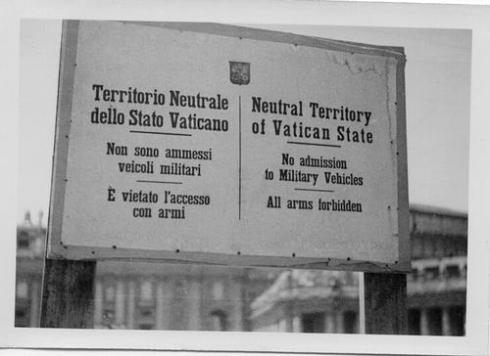
Sign at the edge of St Peter’s Square Rome during WW2
O’Flaherty would then usher them deep inside the Vatican and his organisation would then see to it that they were hidden somewhere in and around Rome.
Eventually, Big Hugh had to start renting houses around the city. He rented one right next to the Gestapo headquarters on the Via Florenze in the belief that this would be the last place the Germans would look for escaped prisoners.
However, as more and more people became holed up in these hideouts Kappler grew ever angrier and saw the priest as a mortal enemy. Not content with making requests to the Pope to curtail the activities of the Monsignor, Kappler sought to confine him to the Vatican and had him watched permanently.
Taking no heed of various pieces of advice, O’Flaherty refused to curtail his activities and refused to be a little less conspicuous in dealing with anyone who sought shelter away from Kappler and his soldiers. Instead, where he had once walked around Rome freely using his Irish and Diplomatic immunity, he began to walk out of the safety of Vatican City using various disguises to avoid those who were set on watching his every move.
He would walk about Rome disguised as a dustman, a policeman, a nun (a very tall nun at that), a beggar and on one occasion at least as a German officer. After one such sojourn around the city he had to scramble over a Vatican wall while being shot at by German soldiers who had ordered him to halt and produce his papers.
On another occasion, he escaped from the Palazzo of Prince Filipo Doria Pamphili, the future mayor of Rome, disguised as a coalman. The Germans had been tipped off that he was there and surrounded the palace on the Via Del Corso. However, when Big Hugh realised they were on to him and were looking for him he went down into the basement and came upon the coalmen making a delivery.
While the Prince stalled the German soldiers for as long as he could, O’Flaherty made good his escape.
He quickly threw his cassock in a sack, covered himself in coal dust and simply walked out passed Kappler’s men who were none the wiser and told him to be on his way as they did not want their uniforms covered in coal. When he got back to the Vatican he telephoned the bemused Prince to let him know he had escaped to safety.
Kappler, who was personally present at the search, could not figure out how the priest had escaped and was reportedly furious.
That was how Hugh O’Flaherty earned the nickname – The Scarlet Pimpernel of the Vatican.
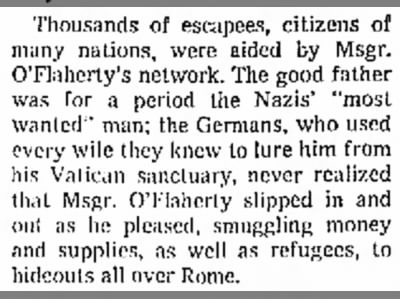
CHAPTER EIGHT
Enraged by his inability to catch the Irish Pimpernel, Kappler now resorted to new tactics.
First he placed a bounty on Hugh O’Flaherty’s life and offered the sum of 30,000 Lire for information which would lead to the capture or the death of the Vatican Pimpernel.
Undeterred, the unusual looking priest became ever bolder and took greater and greater risks in defiance of the Gestapo chief. On one occasion one of the prisoners of war developed acute appendicitis and was in danger of losing his life. On hearing this, O’Flaherty commandeered a career and donned a disguise. He collected the prisoner from his hideout and drove him to the Santo Spirito Hospital and, having arranged things with the nuns who ran the hospital, the prisoner was operated on by surgeons who were otherwise engaged in operating on German infantry.
The POW recovered in a ward surrounded by German soldiers until the big Monsignor rolled up in his disguise once again and took him back to the safe house.
The Pimpernel had struck again!
When Kappler’s offer of a reward for information leading to the capture of O’Flaherty failed, he sought express permission from Berlin for another solution which he dared not attempt without authority from the very top of the Reich. When he received the requested permission, he set about devising the plan which would end in Big Hugh being murdered within the Vatican or just outside it.
There followed several attempts on O’Flaherty’s life.
Kappler had ordered that a thick white line be painted at the edge of St Peter’s Square marking the boundary between Italy and the Vatican state. The line was to remind the Pope where his sovereign state ended and it was to clearly point out the line beyond which Hugh O’Flaherty could not step with any safety.
One of Kappler’s attempts on O’Flaherty’s life was to involve some men speaking to the Monsignor on the Vatican side of the line but then bundling him on to the Italian side where he would be shot while supposedly trying to escape. The men were to approach the tall Monsignor under the guise of seeking help, usher him towards the white line and then more or less push him out on to Italian territory with fatal consequences.
This plan failed, possibly because those who were sent to manhandle the big man didn’t fancy the task as the closer they got to him the more they would see that he looked like a pretty useful light heavyweight who might not be easy to shift!
Apparently, Kappler’s armed men looked on as their colleagues circled the priest time and time again before abandoning the plan and simply running away. O’Flaherty supposedly just watched these events with some amusement.
Eventually, Kappler decided to send some assassins into the Vatican itself with the intention of killing O’Flaherty after he had said an early morning Mass as was his routine each day.
By this time, thousands of Jews and POW’s were being hidden and the cost of feeding them and hiding them was running to thousands of pounds per month. D’Arcy Osborne and others could no longer fund this privately and so it was agreed that the British Government and others would technically lend monies to the Vatican and these same monies were smuggled out to the escapees.
With this scale of an operation going on under his nose Kappler was ever more desperate to bring it to an end and he thought that the way to do that was to simply kill O’Flaherty.
A plan was hatched to send two men into O’Flaherty’s early mass. At the end of the mass the two men were instructed to grab big Hugh and kill him as he left the church.
However, this plan was discovered by the ever-resourceful John May who warned O’Flaherty and suggested that he should skip saying Mass just for one day. As previously mentioned Big Hugh was said to be open to taking risks, – many said unnecessary or even reckless risks – and he would hear no argument about abandoning his morning mass declaring that unless the men concerned had guns he would give them a mighty battering with his fists – Priest or no Priest – if they tried to rough him up.
The following morning, once the mass had finished the two would be assassins, who were easily identified, found themselves surrounded by Swiss Guards and Vatican Policemen who made sure they failed in their mission. Instead the two men were handed over to a group of Yugoslavian Partisans who were being hidden by O’Flaherty and his escape crew, and they promptly delivered a message to Herr Kappler by inflicting various injuries on the agents concerned and then throwing them back over the White line so they could receive medical treatment from the Germans.
The Plan to terminate the bespectacled priest which had been authorised by Berlin had failed and Herr Kappler was once again less than pleased!
CHAPTER NINE
The Via Rasella is a long sloping street in the heart of Rome. It starts close to the Quirinal Palace and slopes upwards to the Via Delle Quattro Fontane where the magnificent Palazzo Barberini sits looking down the sloping Rasella.
Immediately opposite the Palazzo, on the left had side of the street as you climb up the Rasella and on the corner of the Quattro Fontane, sits the building which housed the original Scots College where young Scottish Men were trained for the priesthood.
However, by March 1944 Scots College was devoid of students due to the war although a janitor remained.
During the morning of 23rd March a dustman gently wheeled his dust cart up the Via Rasella slope. He paused almost half way up while a column of the German 11th Company, 3rd Battalion, SS Police Regiment soldiers marched past on a pre-ordained route. The soldiers of the battalion were veterans of the Italian/Austrian Army who had seen action on the Russian Front and had chosen service in the German ran SS rather than face another tour on the Eastern Front.
At the appropriate time, the dustman lit a delayed fuse and quietly departed the scene. The subsequent explosion caused mayhem and killed many of the marchers. However, a squad of 15 partisans then appeared and opened fire on the remaining soldiers before escaping into side alleys and disappeared amongst a stunned crowd.
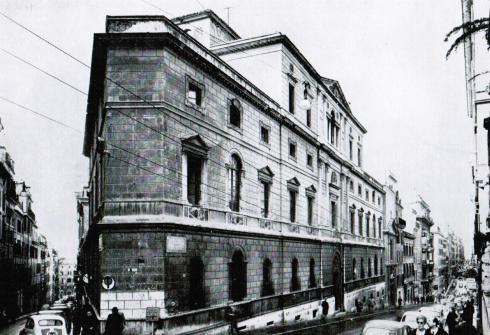
The Original Scots College – The Via Rasella is the narrow street on the left
Of those who were marching 28 died immediately and by the following day 33 of the company had perished though the total number of casualties would rise to 42.
The events of that morning would change Herbert Kappler’s life for ever. The German High Command demanded immediate reprisals and the order was given that within 24 hours the Gestapo should identify 10 Italians for every soldier killed and that these would then be shot in retaliation.
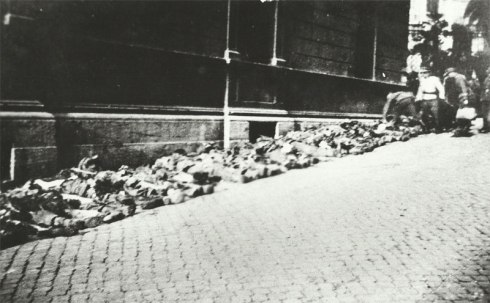
Bodies on the Via Rasella
Various German officers would be involved in the line of command which ordered and organised this atrocity, but the man at the end of that line was Herbert Kappler and it was he who was ordered to find and identify those who were to be killed and then oversee the shootings personally.
There is some evidence to suggest that Kappler tried to resist these orders (he had opposed orders before) but by lunchtime on March 24th the SS Commandant had rounded up 335 souls who were to lose their lives as revenge for the attack which had taken place the previous day.
Some of these were prisoners who were being detained at Gestapo headquarters on the Via Tasso. Others were prisoners from the nearby Regina Coeli jail and 75 were simply Jews. The remainder was made up from civilians who were randomly rounded up while walking on the Via Rasella or who were living in the street at the time. They were just in the wrong place at the wrong time.
The group containing men, women and children, were rounded up at the Palazzo Barberini, taken out to the Ardeatine Caves outside Rome and were shot in batches of 5 people at a time. Some victims had to kneel on top of dead corpses while waiting to be shot in the back of the head.
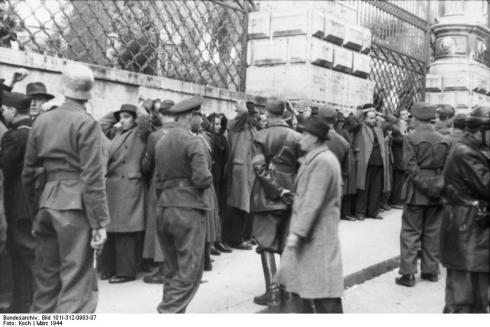
The line up outside the Palazzo Barberini opposite the top of Via Rasella March 1944
Kappler personally shot at least one of the victims as an example to his reluctant troops some of whom were given substantial amounts of Brandy to help them face up to the gruesome task and carry out their orders. As the reluctant firing squad consumed more and more brandy the sloppier they became in carrying out those orders. They would miss their targets and the execution turned into a gruesome farce rather than a military operation. However, after a full day of shootings, all 335 who had been rounded up were dead. To this day some have never been identified.
Among the victims were 5 members of Hugh O’Flaherty’s escape line.
The Ardeatine massacre would play a significant part in turning the citizens of Rome against any notion of German rule. With the advancement of the allied forces in Anzio and thereafter Monte Casino the writing was on the wall for the Germans in Rome and within a few weeks of this atrocity they had abandoned the city altogether as now everyone was against them.
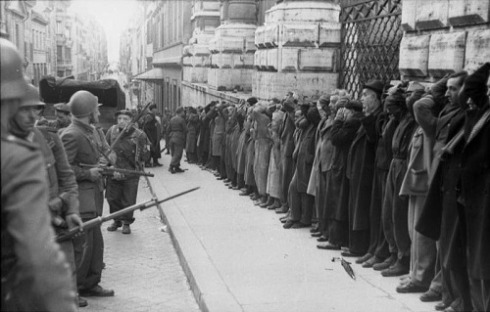
On June 5th 1944 the Allies entered Rome in procession to a tumultuous welcome and hundreds of thousands would cram into St Peter’s Square to hear a message delivered by Pope Pius XII. However, the advance party of the American 5th Army had in fact entered the city the day before, the 4th of June.
At the head of that army was General Mark Clark who drove up to St Peter’s Square and walked to the bottom of the steps surrounded by Bernini’s famous columns only to be greeted by a somewhat odd looking Irish cleric who just happened to be standing there for reasons which were not immediately obvious to the general. Big Hugh thrust out a huge fist and said to the soldier ‘Welcome to Rome! Is there anything I can do for you?’

CHAPTER TEN
After the war, various German soldiers and officials would stand trial for war crimes. They included General Albert Kesselring or “Uncle Albert” as he was known who had been the overall commander of the German forces in Italy. Kesselring would only spend a few years in Jail (The Italians refused to execute him) and at his trial the court was presented with letters requesting clemency and forgiveness from people like Viscount Montgomery and Winston Churchill. He was released from prison in 1952.
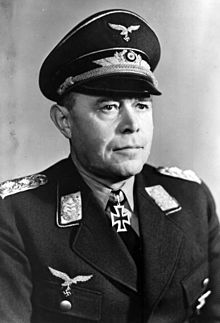
Albert Kesselring
Various Others including General Von Mackensen (Commander of the 14th Army stationed in Rome) and General Kurt Malzer who was the commandant in charge of Rome itself were both imprisoned for war crimes. Malzer died in 1952 and Von Mackensen was released from custody in the same year. Both were involved in the Ardeatine massacre.
Herbert Kappler was to be altogether different. Like the others he was not to be executed but such was the horror at the Ardeatine massacre he was ordered to remain in prison for the rest of his life and to spend at least 4 years in solitary confinement. He was detested throughout Italy and beyond.
CHAPTER ELEVEN
Sir Nicholas Winton is rightly lauded for saving the lives of 669 children from Czechoslovakia during the war. He was given a knighthood and received various other awards for his humanity and bravery.
Oskar Schindler is credited with saving the lives of 1200 Jews by employing them and keeping them safe in his factories in Poland. He was named Righteous Among the Nations by the Israeli government in 1963.
And what of Hugh O’Flaherty? Where does he stand in comparison to these two great and very brave men?
When General Mark Clark shook Hugh O’Flaherty’s had on the steps of St Peter’s on June 4th 1944 big Hugh was responsible for saving the lives of and hiding over 4,000 escaped prisoners of war in and around Rome. Accounts vary as to how many others he was responsible for. What is certain is that Sam Derry who kept “official” records was able to confirm that at the time O’Flaherty’s organisation was looking after 3,925 escapers and men who had succeeded in evading arrest. Of these 1,695 were British, 896 South African, 429 Russian, 425 Greek, 185 American, and the rest from 20 different countries. Some accounts say that counting escaped Jews and other refugees the Irishman was responsible for saving between 6500 and 8000 souls.
One touching account recalls a Jewish mother and father approaching the Monsignor on the steps of St Peters in late 1943 and presenting him with their young son. The couple handed O’Flaherty a solid gold chain and begged him to use it to fund their son’s escape from Rome. The big Irishman not only escorted the son to safety but quite separately helped to hide the parents in another part of Rome.
After the war was over, the Monsignor turned up where the couple were staying and reunited them with their son. He also gave them back the gold chain. He had kept it in a drawer in his room and it lay there completely unguarded despite being of significant value. Others within his quarters knew it was there and apparently chided him for leaving such a valuable object unguarded. As was his want, O’Flaherty’s reply was simple: “And just who the hell is going to steal it from me? This is The Vatican?” End of discussion.
Even after the war, O’Flaherty took the view that there was still work to be done. Rome may have been liberated by the allies but there were still POW camps, only now it was the Italian fascists and Germans who were being held prisoner. He was fond of declaring that ‘God has no country’ and set about doing exactly what he had done before. He visited prisoner of war camps, compiling information for tracking down families and informed Italians and Germans that their men were safe, alive and in custody where they would be treated fairly.
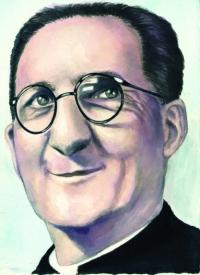
After the war, he commandeered a plane, travelled to Jerusalem to organise immigration and repatriation to Israel for the Jews he’d helped and who now wanted to leave Europe. He also flew to South Africa, setting up a network to trace Italian prisoners of war who were imprisoned there for the benefit relatives at home.
While the Second World War officially ended in 1945, for Hugh O’Flaherty it would continue for quite some time afterwards.
CHAPTER TWELVE
As Rome fell to Allied forces, Herbert Kappler and other prominent Nazi commanders attempted to flee Rome and realising that their war was ending they sought refuge, escape or surrender in various ways. It is said that at one point Kappler unsuccessfully tried to seek refuge in the Vatican but eventually he went north and sought shelter behind German lines in the North of Italy. However, eventually he surrendered at the end of the war and was arrested by British authorities in 1945. Very few of those in charge of Rome during the German occupation were executed (the exception being the torturer Koch who even Mussolini had despised) as the British and Americans had no stomach for executions and actively sought clemency for Generals such as Kesselring who had been in overall charge. However, the Romans, in particular, wanted blood and in Kappler they had a readymade villain who was publicly hated and despised because of the Ardeatine caves massacre. Accordingly, he was turned over to the Italian government in 1947, and tried the following year by an Italian military tribunal which sentenced him to life imprisonment in the Gaeta military prison about 100 Kilometres south of Rome.

Kappler in custody
Even before his trial, Kappler knew that he was effectively a doomed man. His wife divorced him and refused to let any of his children visit him in Prison. The Italian public demanded his execution and there was great disappointment when he was sentenced to life imprisonment.
For his part, Kappler defended himself by saying he was a soldier following orders and that it was his duty not to question orders in war even if he privately didn’t agree with them. His defence team pointed out that there was considerable evidence that he had tried to withstand certain orders, especially in relation to the transportation of Jews, and that by so doing he had saved lives.
However, the fact remained that he had been in charge of Rome when over 2000 Jews were deported never to return and that he had personally overseen the massacre of 335 people at the Ardeatine Caves.
In the eyes of the Italian public he was a monster.
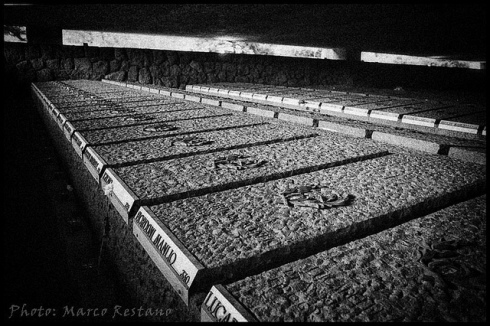
Graves of those murdered at the Ardeatine Caves on 24th March 1944
Yet, even before his trial the events surrounding Herbert Kappler took an extraordinary turn. He was held in solitary confinement and locked away from the outside world even before any sentenced had been passed. He was to have little or no communication with anyone apart from the visits from his legal team.
Then, one day he wrote a letter. He wrote several letters, mostly about his defence and so on, but this letter was different. It was delivered to the intended recipient who read it, raised his eyebrows somewhat and pondered at the request that was made within the body of the letter.
Sometime later, for the very first time Hugh O’Flaherty walked through the gates of the Gaeta Prison, strode into a room and came face to face with the former SS-Obersturmbannführer Kappler who had been so desperate to kill him during the war.
Big Hugh would be Kappler’s only regular visitor for years. Every month the Irishman would turn up at the prison for the sole purpose of visiting the former German military commander. They would talk about literature, religion, God, war, morals and whatever took their fancy.
Kappler expressed the desire to convert to Catholicism but big Hugh counselled against this prior to his trial as it would look mighty suspicious and as if it was a move designed to influence those who would judge him.
Accordingly, Kappler delayed any conversion but in 1949, having been sentenced to life imprisonment, Hugh O’Flaherty privately baptised Herbert Kappler into the church. Kappler’s conversion would not be made known for over a decade and the big Irish Monsignor refused to talk about it when it did become public knowledge.
He also refused to talk about the fact that he visited Kappler each and every month for years to come during which time the two became close. Kappler would later say that his once mortal enemy refused to force religion on him, never judged him and gained his never-ending respect and friendship.
CHAPTER THIRTEEN
During those years after the war, Hugh O’Flaherty worked away in his position as chief writer at the Holy See, continued with his work for prisoners and the displaced of all nations, resumed his partying around Rome and played Golf where he came across young Roberto caddying at Rome golf club.
He played golf whenever and wherever he could and there is a story which tells of him playing on a golf course outside Rome when he came upon a sort of makeshift shanty town at the side of one of the fairways.
There was a series of ramshackle buildings which were barely fit for habitation, a rundown and abandoned church and a whole series of lean to type houses and shelters.
Big Hugh abandoned his round of golf to find out more about who lived there, why they lived in such run-down conditions and who, if anyone, was doing anything for them.
When it became clear that the people and the village had more or less been abandoned by the authorities, he made it his business to lobby for funds, have improvements carried out to the houses, get jobs for the men and to generally bring the village back to life. He had the church restored and from that day on he came to the village to say Mass each Sunday.
However, within the walls of the Vatican he was still scene as a maverick and an outsider. Many in the curia saw him as a risk taker and someone who, during the war, had placed his own desires and ambitions before the overall good of Mother Church. He was destined never to rise higher than the rank of Monsignor while others were promoted and received “in house” acknowledgement.
Hugh hated Vatican politics and eventually it began to annoy him.
CHAPTER FOURTEEN
During his years in Rome, especially during the period when he ran the Rome escape line, Hugh O’Flaherty had associated with some amazing people and had become a very close friend to many.
Those prominent in the Rome escape line included:
Sir Francis Godolphin D’Arcy Osborne, cousin to the Duke of Leeds, and British Minister to the Holy See. Osborne would later become Duke of Leeds and sit in the House of Lords.
John May, Osborne’s butler who O’Flaherty described as “the most magnificent scrounger I have ever come across.” May had an incredible talent for obtaining things that weren’t supposed to be obtainable and had friends everywhere, particularly in the black market. Numerous useful people owed him favours. As shrewd, suspicious and careful as O’Flaherty was large-hearted and willing to take huge risks, John May proved to be the perfect counterpart to the Monsignor.
Count Sarsfield Salazar of the Swiss Legation, very helpful in procuring neutral Swiss identity papers and oiling diplomatic wheels. Salazar would provide private funds for food, clothing and the renting of safe houses.
Thomas Kiernan was the Irish ambassador to the Vatican and like Osborne had to adhere strictly to his country’s policy of neutrality. However, his wife, the noted singer Delia Murphy, had a freer hand and helped where she could, often ensuring that O’Flaherty had the use of the Irish Legation’s car when he needed it. The Ambassador and his wife often passed information picked up from the German diplomatic corps back to O’Flaherty and on at least one occasion Delia Murphy smuggled escaped prisoners to safety in the back of the official car.
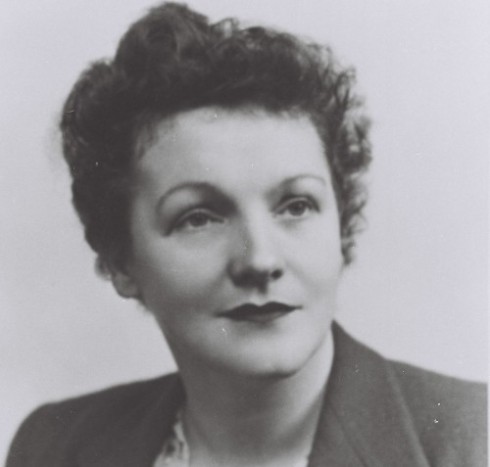
Delia Murphy
Molly Stanley, a middle-aged English governess who lived with the Duchess of Sermoneta, was another good friend of O’Flaherty’s. The very first time she ever laid eyes in big Hugh he was performing card tricks for the Duchess’ son! She turned out to be a tireless worker on his behalf and often posed as his female companion when Hugh was in disguise walking around Rome. The Germans were looking for a priest, not a couple! She had lived in Rome since her early twenties, and her insider’s knowledge of the city was invaluable.

Molly Stanley
Henrietta Chevalier was a five foot four Maltese woman who would hide escaped prisoners throughout the period of the escape line. She lived with her five daughters and two sons in a tiny apartment which was often raided by Kappler’s men yet they never found any evidence of the fugitives. All of them lived under fear of certain death if they had been caught.

Henrietta Chevalier
Major Sam Derry was a member of the Royal Artillery and had been one of the thousands who escaped at Dunkirk. He was later imprisoned in the Chieti Camp in Italy where he was invited to join and eventually take charge of the escape committee. On a train journey through Northern Italy, Derry managed to throw himself from the train and escaped his captors. Derry headed to Rome and sought out The Big Monsignor, who promptly asked him to join the ‘Council of Three’ taking charge of organisational details.
John Furman, a Lieutenant, escaped in December 1943 with Lieutenant Bill Simpson and Joe Pollak a Czechoslovakian Jew, and was brought to The Monsignor in Rome. Furman and Simpson had been good friends with Sam Derry and later Furman, Simpson and Pollak took over the risky job of guiding escapees to secret locations and delivering food supplies and clothes.
Bill Simpson was a Scottish Lieutenant who escaped with Furman and Pollack, came to Rome to find O’Flaherty at the steps of St Peter’s. One of the many duties executed by Furman and Simpson was the distribution of turkeys, wine, cigarettes and special parcels at Christmas as, apparently, O’Flaherty had others prepare hundreds of wrapped parcels for distribution to others who were hiding all around Rome.
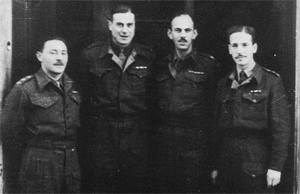
Messrs Furman, Derry, Byrnes and Simpson – all members of the Rome escape line
Princess Nini Pallavicini, a young widow from one of Rome’s oldest aristocratic families. She had been discovered operating an illegal radio and had only escaped arrest by jumping out a window. O’Flaherty found a room for her in his own place of residence, The German College, in the Vatican. The Princess would remain a fugitive for the rest of the war but proved very adept at forging documents and official papers.
Prince Filipo Doria Pamphili, a member of one of Rome’s most noble and formerly “Papal” families who would go on to be a future mayor of Rome. It was from the Prince’s Palazzo that O’Flaherty would escape as a coalman.
There were many others including tram drivers, postmen, policeman, Swiss Guards, Nuns, Fellow Priests and all sorts of people who would help the big Irishman hide thousands of fugitives all across Rome.
CHAPTER FIFTEEN
Pope Pius XII died on 9th October 1958 at Castel Gondolfo. He had steered the Vatican through the war years and had come in for considerable criticism and praise for his actions or supposed lack of them during the conflict.
After the war, he had known that Hugh O’Flaherty had remained as one of the longest serving head writers to the Holy See and that he had continued to mix with the great and the good within Rome and without.
Pius, for whatever reason, never sought to promote O’Flaherty above the rank of Monsignor – perhaps on the advice of others within the Curia.
Another man who was well outside the workings of the Curia was Cardinal Angelo Giuseppe Roncalli, Archbishop of Venice who chose to stay at home and listened the late Pontiff’s funeral being broadcast live from The Vatican.
Roncalli was an interesting man who had been born in Bergamo near Milan and who had spent much of his priestly life serving in places like Bulgaria, Turkey and Greece.
Immediately prior to and during the war years, while acting as Papal Nuncio, Roncalli had saved and helped many refugees including many Jews. In many respects, he was a man with a lot in common with Hugh O’Flaherty.
In 1944 Roncalli had been appointed by the Pope as Apostolic Nuncio to recently liberated France. His main job was to oversee the retirement of those clergy in France who had collaborated with the German regime. This brought Roncalli face to face with critics of the church and with Bishops and others who were seen as traitors in the eyes of the French and who Rome wanted “retired”.
He was not a popular choice within the Curia and Secretary of State Domenico Tardini for one did not approve describing Roncalli as no more than “an old fogey”. Roncalli had been made an Archbishop as far back as 1925 and so Tardini and others thought of him as having gone as far as he could go within church circles. He was not an “inside” man and certainly not someone for the future.
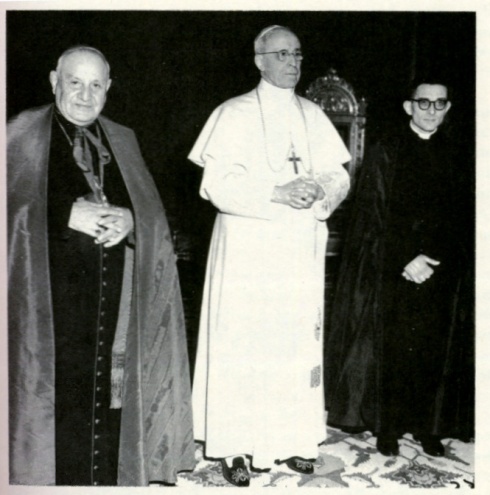
Cardinal Roncalli with Pius XII
However, on 29th November 1952, Roncalli received a phone call from his friend Giovanni Montini who advised him he was to become Cardinal Priest and Patriarch of Venezia and the old fogey took up his new role on 12th January 1953. On 15 March 1953, he took possession of his new diocese in Venice and as a sign of the impact he had made in France and of the esteem in which he was held by the French after the war, the French President, Vincent Auriol, claimed the ancient privilege possessed by French monarchs and bestowed the red biretta on Roncalli at a ceremony in the Élysée Palace.
It was against this background that after the death of Pius XII Roncalli travelled to Rome on 11th October 1958 for the purposes of taking part in the forthcoming Papal conclave. The elderly Cardinal knew that this would be his one and only attendance at a papal conclave and such was his view of what was to come that he purchased a return ticket for the train.
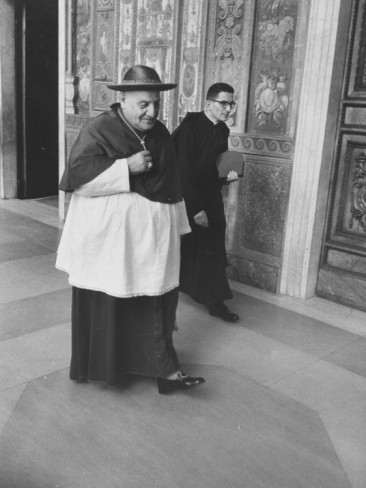
The Old Fogey on his way to the Papal Conclave of 1958
However, after 11 ballots, at 4: 30 pm on the afternoon of 28th October the “Old Fogey” was elected Pope and in the first of several surprise decisions he decided to be the first Pope for some 500 years to take the name John.
Within the Curia he was considered as no more than a stopgap Pope, an outsider, a caretaker who, due to his age (76), would only be keeping the Big Hat warm for one of their own who had been hotly tipped to succeed Pius. The man concerned was Giovanni Montini, who by this time was Archbishop of Milan but who had not yet been elected Cardinal – something Roncalli would correct in his very first consistory.
Under Pius XII, the then Monsignor Montini had more or less ran the Vatican along with his close friend and colleague Monsignor Tardini. The new Pope promoted both to the position of Cardinal and formally appointed Tardini as Secretary of State to the new Papacy while Montini looked after Milan and various other high powered Curia positions.
Tardini was a reluctant Secretary of State and made it plain to the new Pope that he was not keen to serve because he had often disagreed with the views of the then Cardinal Roncalli in the past. He also made it plain that, with respect, he still saw the new Pope as “an old fogey”. Accordingly, he begged to be allowed to retire from Vatican duties and be released to perform pastoral work in the country and with children.
Alas, Good Pope John, as Roncalli would become known, would have none of it. He declined the Cardinal’s request and insisted Tardini serve as Secretary of State. It was a position he would hold until his death in 1961.
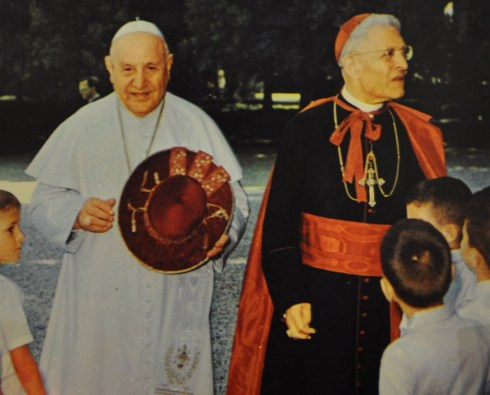
Cardinal Tardini, Secretary of State, with the Old Fogey who would cause him so much trouble
Subsequently, it would be said that Pope John would often feel outmanoeuvred throughout his papacy by the “insiders” within the Curia and that he would be an altogether different type of “Prisoner within the Vatican”.
Although there would be some considerable evidence to the contrary at least in some respects.
And all the while over at the Office of the Holy See, the Chief Writer would continue in his role as Monsignor, would go to parties around town whenever asked and would sneak off to the golf course whenever he could.
What he would not do was discuss his ongoing visits to Herbert Kappler each month (it is not clear if these met with Vatican approval), his activities during the war years or his growing frustration with what he saw as extremely annoying Vatican politics.
CHAPTER SIXTEEN
Because of his fame throughout Rome and his almost celebrity status, Hugh O’Flaherty undoubtedly faced a considerable degree of backbiting and some considerable envy within the Vatican after the War.
In 1946 he had been promoted to chief writer to the office of the Holy See but he would rise no further within Vatican circles.
However, with the arrival of the new Pope John XXIII in late 1958 there was to be a bit of a shakeup within Vatican circles as “The Old Fogey” proved to be less of a caretaker than many had thought although he would reportedly face regular opposition from Curia insiders.
One of the changes he eventually made was at the office of the Holy See where it was decided that Hugh O’Flaherty was to move on from the position he had held for over 12 years.
He would not only be moved out of the office he had occupied for many years but out of Rome itself.
Quite why Big Hugh should be moved on by the new Pope remains a matter of conjecture although as we shall see it may just have been decided that some in The Curia could not stand the idea of “The Old Fogey” and the “Vatican Pimpernel” being together in the one place for too long.
But what was the new Pope and his Curia to do with the golfing and partying Monsignor?
The result was that it was decided to make him the Papal Nuncio to Tanzania and it was an appointment big Hugh viewed with relish as it was to be a new challenge and represented him being the direct agent of Pope “Fogey” himself.
However, it was an appointment that was never to be as before he could take up the position Hugh O’Flaherty suffered a massive stroke while saying mass in June 1960 which brought his Vatican career to a premature end.
After the stroke, he remained severely unwell and he was forced to retire to Ireland where he lived in the town of Cahersiveen with his sister. He never really recovered his health and although he would help out in the local church saying mass and still played a round of golf, his health problems curtailed his once boundless energy but never his brogue and caustic wit.
In 1963, Eamon Andrews featured the Rome escape line on an edition of This is Your Life which concentrated on the life of Major Sam Derry who had recorded the details of the Rome Escape line in an autobiography. Throughout his period of involvement, Derry had kept records of all the POW’s who had been helped and at various times those records had been buried in the Vatican gardens for safekeeping.
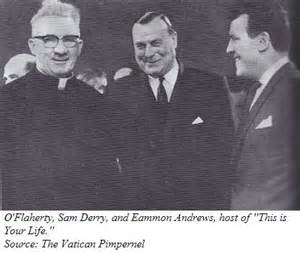
Others such as Lieutenant Bill Simpson had also written books, but Big Hugh was reluctant to even talk about the war let alone discuss his own heroics and rejected all suggestions that he had been anything like a hero.
At the end of the This is Your Life Programme the final guest, or guest of honour if you like, was a somewhat frail but still lively Hugh O’Flaherty. Originally the This is Your Life team had wanted to make the programme about O’Flaherty but after taking soundings from friends and family they realised that Hugh would not appreciate the gesture as he liked a quiet life and shunned all publicity. However, he was delighted to be asked to appear briefly on a show which highlighted the heroism of Sam Derry who, live on air, very quickly made it plain that there would never have been any escape line at all without the genius and the bravery of the charismatic Irishman with the tousled hair and the bulbous nose.
Not long after the programme was aired, Hugh O’Flaherty succumbed to a further stroke and died at home in Cahersiveen on 30th October 1963. He was 65 years of age. He was buried in a simple grave in the grounds of The Daniel O’Connell Memorial Church in Cahirciveen and his headstone proclaimed “God has no country!”

His former colleague, Giovanni Montini, had been elected Pope just a few months before on 21st June 1963. He had been the hot favourite to succeed John XXIII and he was elected after the sixth ballot of the conclave before which Cardinal Testa of Bergamo completely lost his temper with his fellow Cardinals and angrily addressed the assembled conclave demanding that all and any opposition to Montini be withdrawn immediately.
CHAPTER SEVENTEEN
When Hugh O’Flaherty died, his obituary was carried on the front page of the Wall Street Journal and in the New York Times as well as various other newspapers around the world.
The Headline in the New York Times Proclaimed “The Pimpernel is Dead.”
As mentioned, Sir Nicholas Winton had received a knighthood for his saving of 669 Czech children and Oskar Schindler had saved some 1200 Polish men, woman and children.
Hugh O’Flaherty is credited with saving the lives of, or at least hiding, between 6,500 and 8,000 people of various nationalities. One report states that he personally saw to it that over 1700 people of the Jewish faith were hidden in and around Rome and as such were saved from execution or deportation to the concentration camps.
His own personal bravery, audacity and willingness to take personal risks in saving the lives of others was recorded in numerous books and accounts of Rome during the war years.
That is why after the war he was made a Commander of the British Embassy by the British Government (much to his Republican amusement), was awarded the Congressional Medal of Honour with the Silver Palm by the USA and received various awards from the Governments of Canada, Australia, South Africa, Israel, Russia and others.
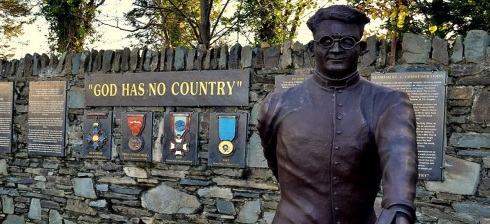
x
All the medals and honours were sent home to his sister to keep in a drawer and were of absolutely no significance to him. He sought no personal recognition whatsoever and shunned all personal publicity.
His one-time colleague, friend and co-conspirator Prince Filipo Doria Pamphili had gone on to become Mayor of Rome after the war and though his offices, The Italian Government awarded O’Flaherty a private pension for life in recognition of his heroics in saving and serving thousands of Italians. The Monsignor never collected so much as a penny of the money concerned.
In Ireland, his actions went unrecognised for many years although eventually a grove of Italian trees were planted in his honour in the Killarney National Park.
However, people who knew of his actions and his work decided to form The Hugh O’Flaherty Memorial Society with a view to gaining him proper recognition and to furthering the kind of attitude and actions “Big Hugh” himself represented in life. The Society has grown in membership and stature over the years and there are now various respected awards, festivals and other events bearing Hugh O’Flaherty’s name.
Yet, I first came across the story of the big Monsignor in a book entitled “The sixteen most famous Irishmen you have never heard of!”.
On October 31st 2013 A statue of big Hugh was unveiled in his hometown of Killarney County Kerry. The statue is one which is more or less life size, bronze and shows the bespectacled Hugh striding out supposedly across St Peter’s square.
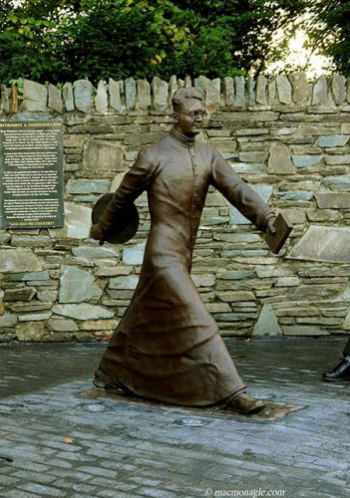
50 years after his death, the unveiling of the statue was witnessed by international and local dignitaries, including the assistant attaché at the US Embassy George Sands, Canadian ambassador Loyola Hearn, British Ambassador Dominick Chilcott, the Papal Nuncio, Archbishop Charles John Brown, and Nurit Tinari-Modai of the Israeli Embassy.
Colonel Sam Derry, his son William and his wife Marion were also present as were Mo and David Sands, the grandchildren of Henrietta Chevalier.
In June 2016, The Hugh O’Flaherty Memorial Society went on a tour to Rome during which they met up with 72 year old Roberto Bernardini, Italy’s first Internationally recognised professional golfer.
The Society presented Roberto with a specially restored Burke Punchiron No 8, dating back to the mid-1930’s. The club was mounted on a backboard with photos showing the Monsignor playing in Rome with three times British Open Champion Henry Cotton.
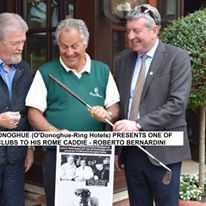
The boy who once caddied for “Big Hugh” continues to coach budding players on the fairways of Rome Golf Course. To this day he recalls his friend, tutor and coach, his most unusual grip and how he could hit the one iron like no one else he had ever met!
CHAPTER EIGHTTEEN
Long after Hugh O’Flaherty’s death, Herbert Kappler remained in custody in the prison at Gaeta, the coastal town south of Rome. Eventually he was the only prisoner in the building. He had tried all sorts of appeals against his sentence but they were all to no avail. The Italians had meant it when they said he would see out his life in prison.
As the years had gone on, Kappler had become most disenchanted with many of his former colleagues and their recollection of history. He was annoyed at how people like Kesselring had been not only released but had also written a book which had, in Kappler’s opinion, seriously misrepresented events in Rome during 1943-1944.
After Big Hugh died, Kappler eventually started to correspond with a German nurse by the name of Anneliese Wenger. After a lengthy series of letters, Anneliese eventually came to the prison to meet Kappler and after a long series of meetings and letters they eventually married in 1972. Originally their meetings were overseen by prison guards and the couple were allowed no time together in private.
In 1975, at the age of sixty-eight, Kappler was diagnosed with terminal cancer and a year later he was moved to the Celio Military Hospital in Rome.

Anneliese and the West German Government petitioned the Italians to release Kappler on the basis that his condition was terminal but their requests were denied by the Italian who were determined that Kappler would die in custody .
By this time his wife was being given almost unconditional and unrestricted access to her husband in hospital and so on the night of 14th August 1977 Herbert and Anneliese Kappler embarked upon a plan that was worthy of Big Hugh O’Flaherty at his most audacious.
Anneliese came to the hospital as normal that night and no one at the military hospital gave her visit a second thought. She had been a regular visitor for about a year and was known to the security and nursing staff. At around 10pm she placed a sign on the door of her husband’s room which read “Do not waken till 10:00 am”.
One report says that she helped Herbert walk down the back stairs of the hospital without being noticed, and once out in the car park she helped him into the back of a waiting car. Another, more romantic notion, is that Herbert Kappler, who by this time weighed no more than 45 Kilos or so, was smuggled out of the hospital by his wife while hiding inside a rather large suitcase which she rolled out to her car.
What is certain, is that Anneliese drove the former SS chief out of the city of Rome and all the way through Italy overnight. By the time the hospital staff realised that he was gone he was safely back on German soil never to return.
A huge outcry followed, with the Italian Government and public demanding that the monster of the Ardeatine caves massacre be returned to Italy to serve the rest of his sentence. The German Government were not so accommodating, and, even though Kappler was at the home of his wife in the little town of Soldau, they did little if anything to ensure his speedy return.
During his captivity, Hugh O’Flaherty had told Kappler that men such as him with guns and arms were foolish to think that they could ever think to conquer the spirit and the soul of the man who wants to be free. O’Flaherty had learned that at an early age with the Black and Tans and perhaps it explains why he was so fearless or reckless during the German occupation of Rome.
He preached that no man should live in fear of anyone or any country who wanted to restrict his movement and the enjoyment of life by force. According to Big Hugh, that would never work. God had no country and would never recognise one as having the right to claim any man through force.
Maybe it was a lesson that Kappler recalled in those last days in captivity and maybe it played a part in the mindset of Kappler and his wife in deciding to organise his escape from the Celio Military Hospital.
Whether he escaped in a suitcase or not, Kappler’s last journey out of Rome was worthy of Hugh O’Flaherty’s escape line at its best.
Six months after his escape, Kappler died at home in his own bed in Soltau, on 9 February 1978, aged 70 and with his wife at his side tending to his final needs.
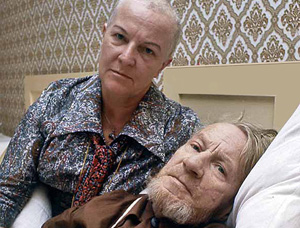
Herbert Kappler at “home” with Anneliese Kappler in Soldau shortly before his death
He had outlived his wartime nemeses and post war friend by some 15 years.
CHAPTER NINETEEN
On 13th March 2013, Jorge Mario Bergoglio became the 266th Pope of the Roman Catholic Church, a title he holds ex officio as The Bishop of Rome, and Sovereign of the Vatican City.
Bergoglio was elected on the second day of the Papal Conclave and on the fifth ballot of Cardinals enclosed in the Sistine Chapel. It is entirely possible that the 76-year-old Argentinian could have been elected Pope in 2005 as in the Conclave of that year he was considered Papable and received an unprecedented number of votes for a Latin American. He was allegedly a close runner up to Cardinal Ratzinger who would go on to become Pope Benedict XVI.
Although the inner workings of any Papal Conclave are meant to remain secret, stories have emerged which suggest that in 2005 Bergoglio made a speech to his fellow Cardinals in which he begged not to be elected Pope and asked those supporting him to pledge their votes to Cardinal Ratzinger in what was to be the fourth and final ballot.
Pope Francis as he was to become is of Italian heritage, his father’s family having fled Italy in 1929 to escape the dictatorial Government of Benito Mussolini, and he grew up on the streets of Buenos Aries.
A former nightclub bouncer, Bergoglio was the first Jesuit to become Pope although it should be noted that he had been effectively all but expelled by the Jesuits several years ago and had very little to do with them for many years prior to his becoming Pope.
Of all the things to know about the new Pontiff for the purposes of this story the most important are as follows,
Prior to his election as Pope, Cardinal Bergoglio had been staying in what is today known as the Casa Santa Marta in Vatican City. The old building which had been home to Sir D’Arcy Osborne had been pulled down and replaced by a new custom built hostel on the orders of Pope John Paul II who wanted to create more modern quarters for visiting priests and clerics.
After his election in the Sistine Chapel, Pope Francis went back to his quarters in the Casa Santa Marta by way of the same mini bus that took him and other Cardinals to the conclave that morning. He refused to travel by any means of the official Papal car and so took the short ride back to his room along with the others from the conclave.
Further, having been elected, he refused to reside in the luxurious Papal apartments and decided to remain resident on the spot where D’Arcy Osborne had been housed as British Ambassador during the war years.
He remains resident in The Casa Santa Marta to this day.
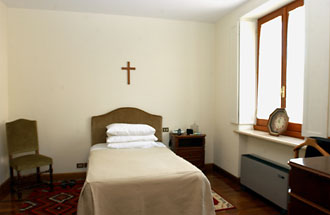
Inside the Casa Santa Marta
As a Priest, the then Father Bergoglio had spent a period of three months residing in the City of Dublin staying at the Jesuit Centre at the Milltown Institute of Theology and Philosophy in Ranelagh.
Perhaps it was while living in Dublin that Jorge Bergoglio first came to hear the story of Big Hugh or maybe his knowledge comes through living at the Casa Santa Marta where some of the escapees were hidden by O’Flaherty, Osborne and May.
Irrespective of how he came to know the story, having been elected Pope the Argentinian would do something that had been overlooked or ignored by all his immediate predecessors.
On Sunday 8th May 2016, the 71st anniversary of Victory in Europe, a group of 200 or so people attended a special mass in the German College in the Vatican. Those attending included members of Hugh O’Flaherty’s family and relatives of those who had worked with him on the “Rome Escape Line”. Three sons of Colonel Sam Derry were present as were the ambassadors from countries such as Germany, Ireland, the U.K., the United States, and Canada, together with representatives of Italian families and others who had helped, and had been helped by, Big Hugh when he was protecting the escaped prisoners of war, Jews and others from the Nazi’s and the Fascists in Rome.
A Plaque was unveiled at the door of the German College commemorating the life and times of Hugh O’Flaherty and recognising just how immense he had been in helping others during the war years and beyond.
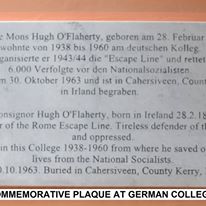
Two wreaths were laid underneath the new plaque, one by a representative of the Irish government, and the other by the U.K.s defense attaché to Italy, Colonel Lindsay MacDuff.
It was Pope John XXIII who introduced the custom of the Pope appearing at the Vatican apartments window each Sunday at noon to say the Angelis prayer or the Regina Coeli.
Each Sunday at noon the incumbent Pope now appears in the window of the papal apartment to give a weekly Angelus address which typically amounts to a short homily about the Sunday readings. After delivering this short reflection on the readings, the Pope proceeds to pray the Angelus Domini (or the Regina Coeli during Easter) and thereafter he greets the pilgrims that are present in the square in various languages of the world.
It was during the Regina Coeli address of Sunday 8th May 2016 that Jorge Bergoglio, Bishop of Rome, Pontiff to the Roman Catholic Church and head of the Sovereign Vatican State addressed the members of the Hugh O’Flaherty Memorial Society gathered in St Peter’s Square below and in so doing, at long last, on behalf of the Catholic Church formally recognised the work and risks taken by Monsignor Hugh O’Flaherty from Ireland during the course of 1942 -1944.
It was on that day that The Vatican State and its elected leader finally joined with the leaders of many other sovereign states around the world in recognising that the big be-spectacled Kerry man was worthy of International recognition for his brave and humanitarian actions during the war and acknowledged that “Big Hugh” had regularly risked his own life in saving others.
The Vatican formally acknowledged Hugh O’Flaherty’s achievements some 50 to 70 years years after every other Government for reasons that remain best known to those who were within the Curia at the time and subsequently.
The Plaque on the wall of the Campo Santo Teutonico reads:
“Monsignor Hugh O’Flaherty, born in Ireland 28.2.1898. Founder of the Rome Escape Line. Tireless defender of the weak and oppressed. Resident at this College 1938-1960 from where he saved over 6000 lives from the National Socialists. Died 30.10.1963. Buried in Cahersiveen, County Kerry, Ireland.”
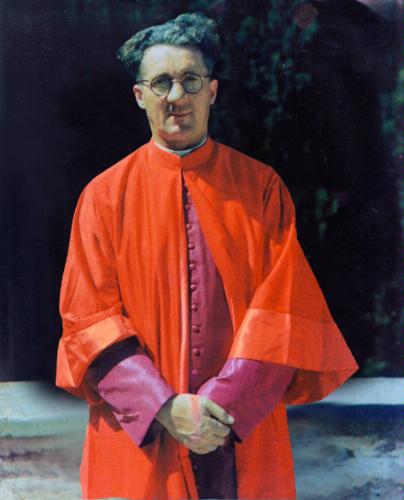
He was, quite simply, God’s one Iron!
CHAPTER TWENTY
The City of Rome has over two and a half thousand years of stories to tell and that is why it is such a captivating and fascinating city to visit.
Many of those stories are undocumented, are the stuff of legend and can never be verified. They are apocryphal and sometimes based on no more than hearsay, legend and rumour. Such stories are often the best and most fascinating that Rome has to offer and of course the city itself is based on the most famous and propagated Roman legend of all – the tale of Romulus and Remus.
Obviously, the tale of Hugh O’Flaherty is a modern story and as such most of it is well documented and easily verified, although I will wager that not all the details are known.
Speaking earlier this year, O’Flaherty’s nephew, also called Hugh, told Vatican Radio that his uncle was a very good humoured and jovial character, but that he was always interested primarily in the present. For this reason, he said, his uncle hardly ever talked about what happened during the war or during its immediate aftermath, even when Lord Beaverbrook, the owner of the British newspaper The Express, then the most widely read newspaper in the world, wanted to do a feature on him.
“Much to my chagrin, my uncle did not want to comment on it!,” O’Flaherty recalled. “As I said, he lived very much in the present, and the past was the past.”
There is no doubt that “Big Hugh” had many a tale he could have told but instead he kept many a secret to himself. Those secrets included many of his experiences during the war, what occurred within the inner workings of the Vatican, his chats with Herbert Kappler, and his relationships with the great and the good of Rome both inside and outside Vatican City.
While the story of Hugh O’Flaherty has been told by many, few have stopped to think about what he changed. He was responsible for changing the information provided by Vatican Radio, the organisation and distribution of parcels by the Red Cross and later other similar international agencies and he also had a significant impact on future Vatican security measures and procedures.
I first became aware of the Ardeatine Massacre when I was taken to the execution site in 1975. The Ardeatine Caves are now a national museum, a place of worship and a memorial housing the graves of the 335 men women and children who were executed on the orders of Herbert Kappler.
The site remains, to my mind at least, one of the most moving and astonishing places to go and see in all of Rome and it has become traditional for the incumbent Pope to visit the site and say mass there as the Bishop of Rome.
It is very much worth a visit.
Earlier this year, I stayed in an apartment on the Via Rasella where the bullet holes and bomb marks created on the morning of 23rd March 1944 can still be seen at the corner of Via Rasella and the Via del Boccaccio. The marks of war stand out clearly on the walls and act as a reminder to all as to what took place there over two fateful days.
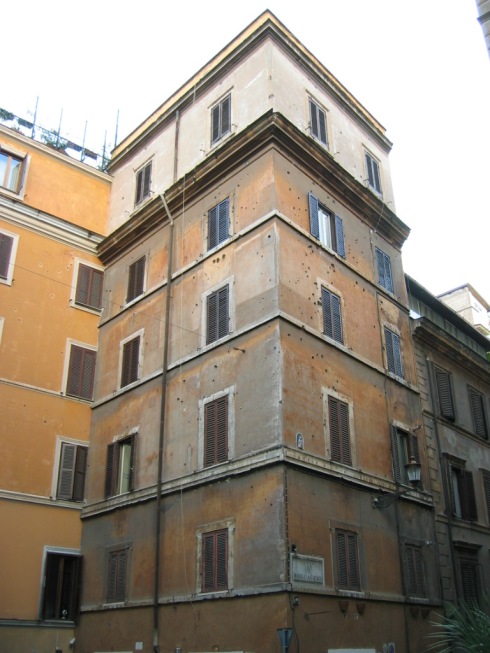
On 30th November 2006, Radio 4 broadcast a play written by Raymond Glendinning called “The Scarlet Pimpernel of the Vatican” which explored the post war relationship between Big Hugh and Herbet Kappler. The play gives a flavour of what the conversations between the two men might have been like when Hugh visited the former SS Commander in prison at Gaeta.
Perhaps, the play serves as one of Rome’s apocryphal and mythical stories which cannot be verified, and provides a fascinating insight into the relationship between the two men.
However, there may just be another apocryphal story concerning the Big Irishman which is worthy of some mention and which everyone and anyone can view as wholly fact or fiction or part true or untrue.
The story concerns the newly elected Pope John XXIII and his reluctant Secretary of State Cardinal Domenico Tardini who, you will recall, was reluctant to serve under the new Pope and who considered him an “Old Fogey” and a Curia outsider.
However, it is now well known that notwithstanding his election as Pope in October 1958, former Cardinal Roncalli felt trapped inside the Vatican and so somehow or other took it upon himself to escape the sovereign state and went walkabout in the city of Rome on various occasions.
Quite how this came about has never been fully explained.
There is an unattributed story which suggests that on the first occasion the new Pope disappeared into the Roman night and went for a walk, the head of the Swiss guard and the chief of Vatican Police turned up unexpectedly and somewhat flustered at the door of Cardinal Tardini to explain that somehow or other the Pope had gone “Missing”.
“What do you mean “Missing”? “asked an astonished Tardini only to be told that the Vatican security services, guards and police had “misplaced” the pontiff and that they had no idea where he was.
The story goes on that all the usual questions were asked about searches and so on with the visitors assuring the Secretary of State that they had looked everywhere and could find no sign of the newly elected Pontiff within the Vatican.
Tardini reportedly dismissed this as “absolutely impossible”, pointing out that the Pope was one of the most recognisable people in the world, wore a uniform that was unique to him and was instantly recognisable anywhere, and that it was therefore absolutely impossible for him to simply walk out of Vatican City undetected by anyone……………… unless he had been in disguise!
In that instant, a light went on and questions began to be asked as to where a Cardinal who had bought a return train ticket to Venice when coming to Rome and who clearly had no intention of staying for long could have gotten his hands on clothes which would make him shrink into the background?
Also, according to Tardini, Cardinal Roncalli was not someone who was overly familiar with Rome itself as he had spent many years abroad and so he did not know secret or back ways in, out and around Vatican City or the city of Rome. How, then, did he manage to get out without being seen by someone? His apartment, and he himself, were surrounded by Swiss Guards and other officials, and so it would be virtually impossible to escape detection unless ……… you knew exactly how to get in and out of the Vatican City without being seen. Tardini would wager that Pope John XXIII did not possess that knowledge and expressed the opinion that there was only one man residing within the walls of the city state who had that expertise and who would be mad enough and bold enough to assist in the smuggling of a Pope!
Mosnignor Hugh O’Flaherty, Chief Writer to The Offices of The Holy See.
It is said that when Big Hugh was asked about the missing Pope he said he knew nothing whatsoever about where the errant Pope might be but that he was sure that the good Lord would look after the Pontiff and that he would return safely….. in due course!
If this apocryphal story is to be believed, the Irishman’s gentle way of relaying his lack of knowledge and his inexplicable belief that the Pope would return eventually, with the grace of God, led to an apoplectic loss of temper on the part of some.
Later that evening, Pope John XXIII, the former Cradinal Roncalli, the “old fogey” of the Vatican as he was described by Tardini, duly returned to the Papal apartments. He had been dressed as an ordinary priest!
Within two months of being elected Pope, on Christmas Day 1958, Angelo Roncalli would officially go walkabout in Rome visiting the Regina Coeli Prison and the Santa Spirito Hospital amongst other places. He was the first Pope to make official pastoral visits around Rome since 1870 much to the consternation of some working within the Vatican security detail and within The Curia.
This had not been expected when Roncalli had been elected and it quickly became clear that this “old man” might just be difficult to control which presented Tardini, as Secretary of State, with a massive headache.
Not only that, having gone “missing” on one occasion, it soon became apparent that the new Pope would not be content with just one late night walk around the eternal city. It is now well documented that Pope John developed a habit for “sneaking” out of the Vatican late at night on his own initiative with no prior consultation and it has been suggested that such activity left Tardini and others completely demented.
Tardini, like Montini, had been trained to believe that the Papacy and the Vatican must not be compromised in any way and must be safeguarded at all times. Under Pious XII they had constantly worried about the Pope being kidnapped or the Vatican being invaded as it had so often in the past.
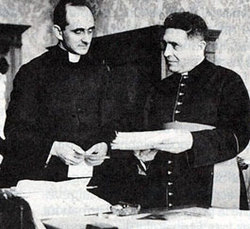
Monsignors Montini and Tardini
Now, Tardini had to deal with a Pope to whom he had reluctantly sworn allegiance but who was behaving in a manner which meant no Curia control and which made Kidnapping much easier and much harder to protect against.
Popes had left the Vatican under disguise before (There is even a story about Pius XII making visits dressed as a Franciscan monk but always accompanied by “Father Montini” and having let The Curia know all the details) but this new Pope was effectively escaping at night and wandering off on his own with no regard to safety or precaution.
The story goes, that like Kappler, Cardinal Tardini suspected, but could not prove, that the new Pope was being, or had been, aided and abetted in this new game of hide and seek by the golfing monsignor, the chief writer to the Holy See who, after all, had been dubbed The Scarlet Pimpernel of The Vatican.
Of course O’Flaherty and indeed the Pope himself denied all such suggestions.
However for Tardini and The Curia, the case of the disappearing Pope was just too much even without proof.
Maybe that is why big Hugh was suddenly made Papal Nuncio to Tanzania and was to be sent to darkest Africa?
Maybe Tardini consulted with Montini and it was decided that helping POW’s escape the Nazi’s was one thing but helping a Pope to escape the Curia was absolutely overstepping the mark and so Hugh had to go!
Maybe, Tardini explained that dealing with one rebel priest who swanned about Rome when he chose to was enough, and that dealing with the wandering Pope as well was just too much!
As mentioned before, quite why Hugh was appointed Papal Nuncio to Tanzania has never been explained but it is known that he would never rank higher than Monsignor and that he came to detest Vatican politics which he knew acted against him.
The massive stroke suffered by Hugh O’Flaherty in 1960 brought about his retiral from the Vatican and saw his eventual return to Ireland and so he never got to Tanzania.
Pope John and his late night solo wanderings continued to cause unprecedented and uncontrollable concerns for Domenico Tardini and unfortunately the poor man suffered a massive heart attack in July 1961 which proved instantly fatal.
Of course, whether Hugh O’Flaherty ever did help John XXIII escape from the Vatican late at night can never been known for sure. However, one thing is absolutely certain.

To improve security, during the period of the Rome escape line, O’Flaherty and his colleagues had resorted to referring to one another by code and gave one another code names. If you recall, O’Flaherty himself was referred to as “Golf”.
Vatican Security had learned a thing or two from the Monsignor and his colleagues and in later years they too gave important personnel code names when referring to them in internal communications.
Following upon his first “disappearance” and until the day he passed away, Pope John XXII, Cardinal Priest Angelo Giuseppe Roncalli, would be referred to in secret by Vatican Security Chiefs and by inner Members of the Curia as “Johnny Walker”!
Allegedly, this made one large Irishman with a rich brogue and a penchant for playing golf laugh like hell.
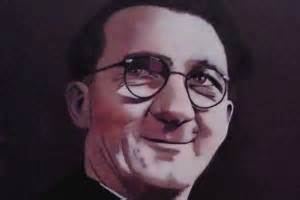
POSTSCRIPT
I write these stories purely for my own amusement.
I enjoy hearing and researching any story involving so called “ordinary people” and the remarkable things they do or have done – and there are plenty of them.
I don’t seek to make any money out of these stories and the telling of them is purely a hobby and a pleasure for me, but I do like to know if others have enjoyed any of the tales concerned and whether they have been inspired to visit some of the places mentioned or read further about the people involved.
Please share this story with as many people as possible and if you enjoyed reading it, then I would appreciate it greatly if you could, in return, see fit to donate to the Celtic FC Charity Foundation via whom I am going to complete a charity sleepout on 12th November 2016 with a view to raising money for the homeless and the needy.
You can donate via this link:
https://mydonate.bt.com/fundraisers/jamesmcginley2
Thanks.
Jim McGinley 30th October 2016
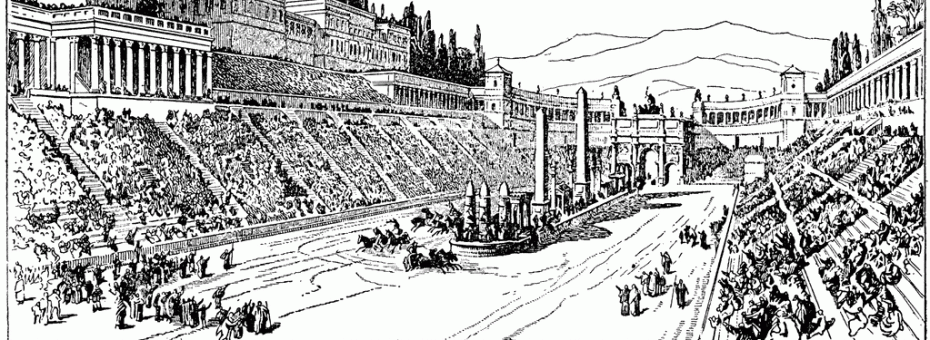
A magnificent man,Jim. And a magnificent nose!
How he ever managed to disguise himself beats me.
Btw,a little follow-up for you,about Sam Derry.
http://www.bbc.co.uk/news/uk-england-nottinghamshire-23189450
Absolutely brilliant story telling, not to mention writing. Thanks. Small donation on its way.
Forgive me for asking, but might you be a John Kelly that I know but haven’t seen in years? Father of Sean and Brendan?
As usual, gre
I had seen the film with, I think, Greogory Peck but this put a hell of a lot of flesh on the bones. Thank you so much and a donation next pay day.
Thanks for that. The Movie was called The Scarlet and The Black, but “Big Hugh”‘s story really does merit the full Hollywood treatment as opposed to a TV movie and it doesn’t cover half the detail including his relationship with Kappler nor the politics within the Vatican. Any donation is greatly appreciated.